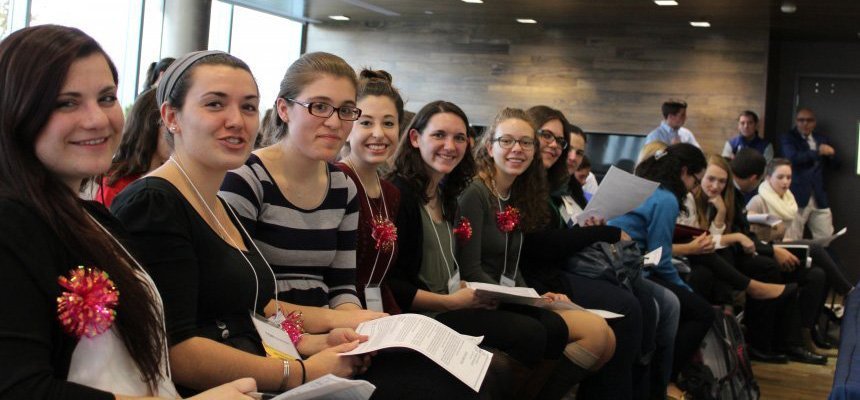
Senior Colloquia
The English Literature Senior Thesis Colloquium ("Senior Colloquium") is the capstone project for the major in English Literary Studies at RWU.
After two semesters of reading, research, seminar discussion, and individual writing tutorials, seniors present research papers (approx. 20 - 25 pages), fielding questions and discussion in a conference style colloquia open to the entire university. This culminating project is one of the highlights of the major and of senior year.
2023 Colloquium: Social Protest Literature
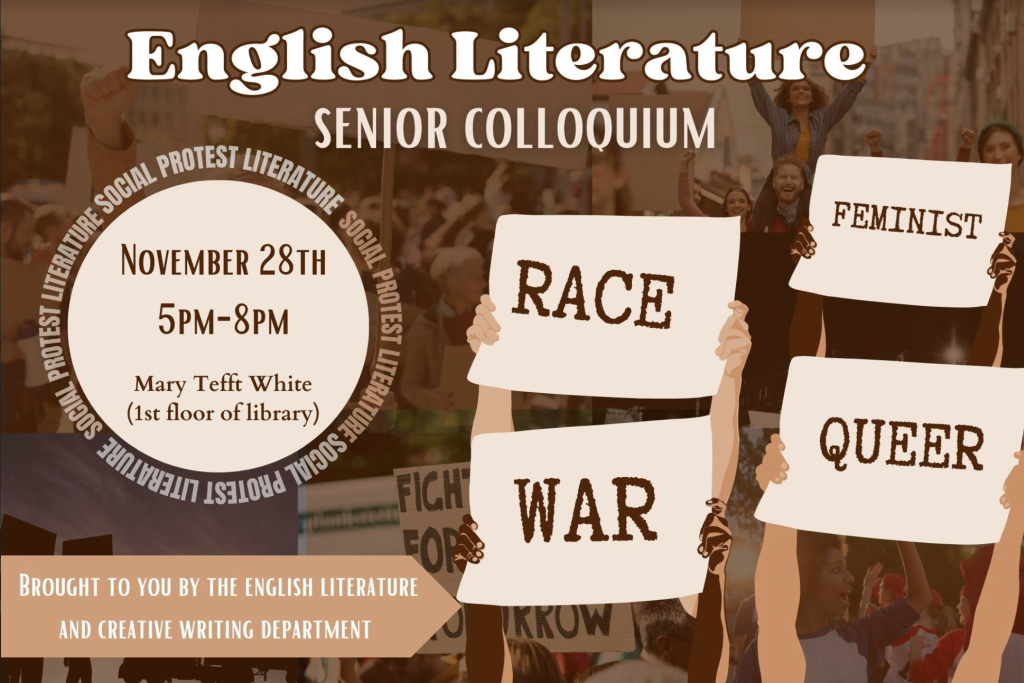
On Tuesday, December 12, The English Literature Program presented "Social Protest Literature," where nine seniors offered an innovative array of topics and ideas about key American social protest texts.

El Segall
The Vietnam War saw a rise in anti-war protest unlike ever before, in every form. Tim O’Brien published multiple anti-war books from his veteran’s perspective, and George Lucas created his Star Wars franchise to emphasize his anti-war stance. Although their works are very different, O’Brien’s books and Lucas’s movies share many of the same themes and events that define Vietnam War protest media.

Jaden Militello
The Vietnam War is often remembered for how it negatively impacted American politics and patriotism. Tim O’Brien’s If I Die in a Combat Zone and David Rabe’s Sticks and Bones compliment each other by highlighting a different side to the war, namely, the way that the Vietnamese were viewed and treated during the war.

Mayson O’Marra
While it is obvious that Larry Kramer borrows part of W. H. Auden’s poem “September 1, 1939” for the title of his play The Normal Heart, this paper will explore how the two are also connected through their use of themes of fear, love, and governmental ineffectiveness.
Zachary Reis
The American Dream has been a concept that has withstood the test of time in modern society. Despite being advertised as a dream of prosperity for all American citizens, it truly was not meant for any person other than the white man. Through an analysis of Lorraine Hansberry’s A Raisin in the Sun and James Baldwin’s The Fire Next Time it becomes evident that the experience and observations of Black citizens during the 1960s support the claim of a non-inclusive American Dream.

Ana Swansey
This thesis delves into the subtle yet profound manifestations of misogynoir within Lorraine Hansberry's play, A Raisin in the Sun. Focusing on the often overlooked nuances of the female characters' experiences, the study employs an intersectional lens to explore the crossover of race and gender.
Jordan Durfee
Historically women have been mistreated and pushed into roles of submission. Adrienne Rich exposes these issues using the personification of time, and mentions of history, throughout her poems “Storm Warnings,” “Snapshots of a Daughter-in-Law,” and “A Marriage in the ‘Sixties,” and directly exposes these issues in her critical essay, “When We Dead Awaken: Writing as Re-Vision.”

Sarah Skinner
The appeal of marriage has dwindled in recent decades, but why and how did that happen? This paper studies how four women in American literature opt out of the traditional role of marriage and children, in preference for their independence.
Jacqueline Tosi
 This thesis delves into the female voices of protagonists in Sylvia Plath’s The Bell Jar and Wendy Wasserstein’s The Heidi Chronicles, mirroring the societal constraints encapsulating women in suffocating “jars.” The influence of second-wave feminism, triggered by women’s dissatisfaction with traditional roles imposed after World War II, provides a backdrop to the narratives. As the 1960s and 1970s witnessed the surge of second-wave feminism, the text explores the challenges women faced in breaking free from these societal constraints. These texts provide insight into the metaphorical jars constraining women during the feminist movement, portraying the evolution of women’s individual agency.
This thesis delves into the female voices of protagonists in Sylvia Plath’s The Bell Jar and Wendy Wasserstein’s The Heidi Chronicles, mirroring the societal constraints encapsulating women in suffocating “jars.” The influence of second-wave feminism, triggered by women’s dissatisfaction with traditional roles imposed after World War II, provides a backdrop to the narratives. As the 1960s and 1970s witnessed the surge of second-wave feminism, the text explores the challenges women faced in breaking free from these societal constraints. These texts provide insight into the metaphorical jars constraining women during the feminist movement, portraying the evolution of women’s individual agency.
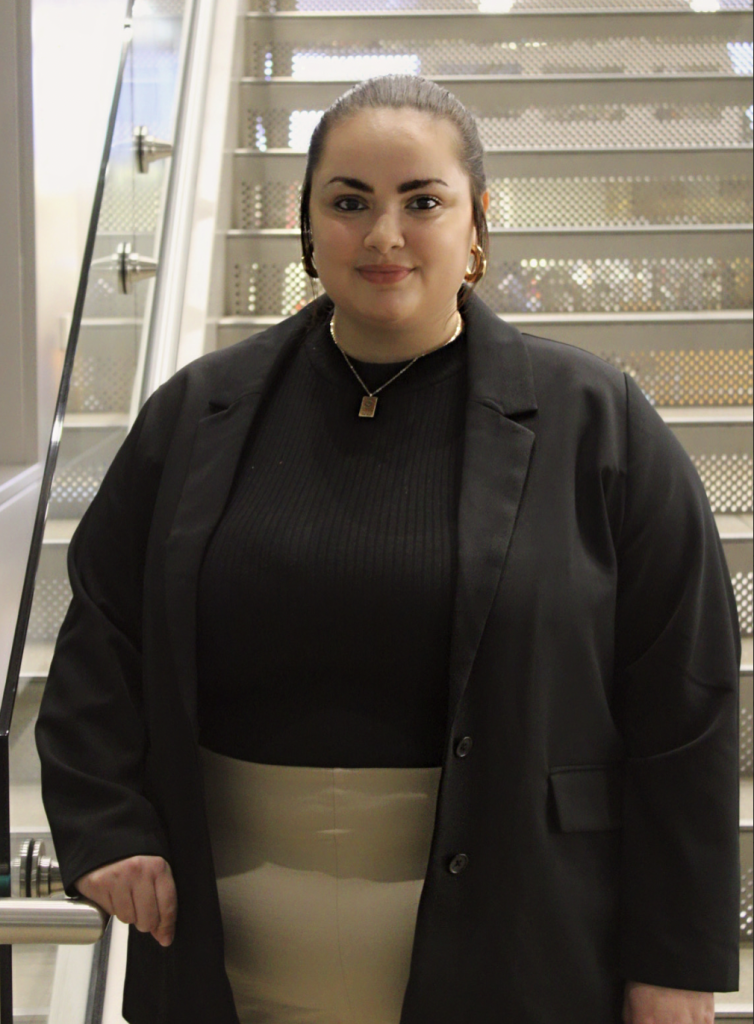
Rachel Herren
In the pieces A Raisin In The Sun, The Bell Jar as well as The Heidi Chronicles there is a great deal of feminism. Hansberry’s A Raisin in the Sun contains three women, each powerful in her own way. Plath’s Esther Greenwood in The Bell Jar faced the challenge of breaking the box in which mid 20th-century society trapped women. Wasserstein’s Heidi character is perhaps the most modern feminist of the three texts, since she challenges social norms for women the most directly.
Literary Challengers VS The Literary Canon– Fall 2022
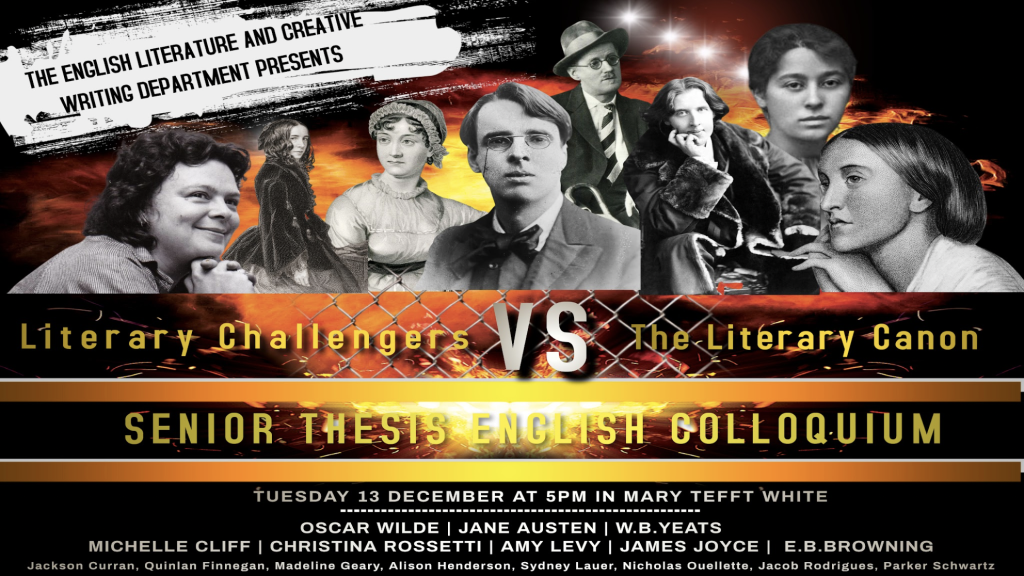 Tuesday, Dec.13
Tuesday, Dec.13
The 2022 Colloquium: Literary Challengers English Literature Program presents "English Literary Challengers," where eight seniors will offer an innovative array of topics and ideas about key figures in British literary history.
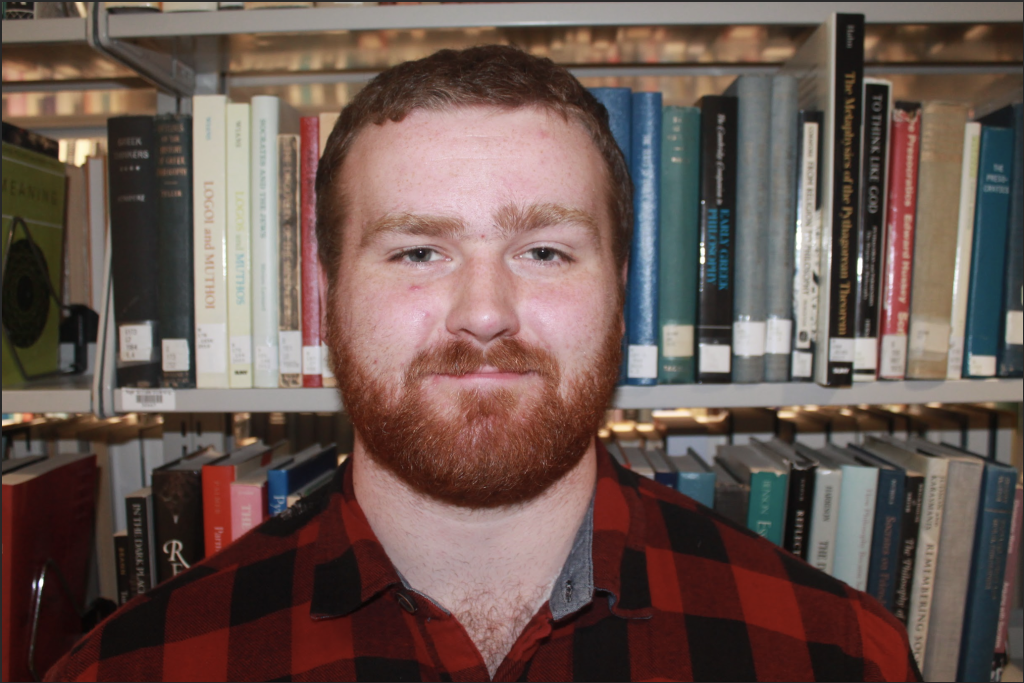
Jackson Curran
“A Country of Unsettled Opinion: An Exploration of W.B. Yeats' Irish Identity"
Delve Into the roots of Irish culture through the identity of one of its most famous writers: William Butler Yeats. Learn what Yeats thought it was to be “Irish.”
Quinlann Finnegan 
“Can Irish Literature Be Considered Post-Colonial? A Study of William Butler Yeats and James Joyce"
This essay reads the works of W.B. Yeats and James Joyce through a post-colonial lens. Drawing on the texts of Derek Wolcott, Ngugi Wa Thionog and Chinua Achebe, this analysis of Years and Joyce reveals how actively their works resist being categorized as “British” literature.
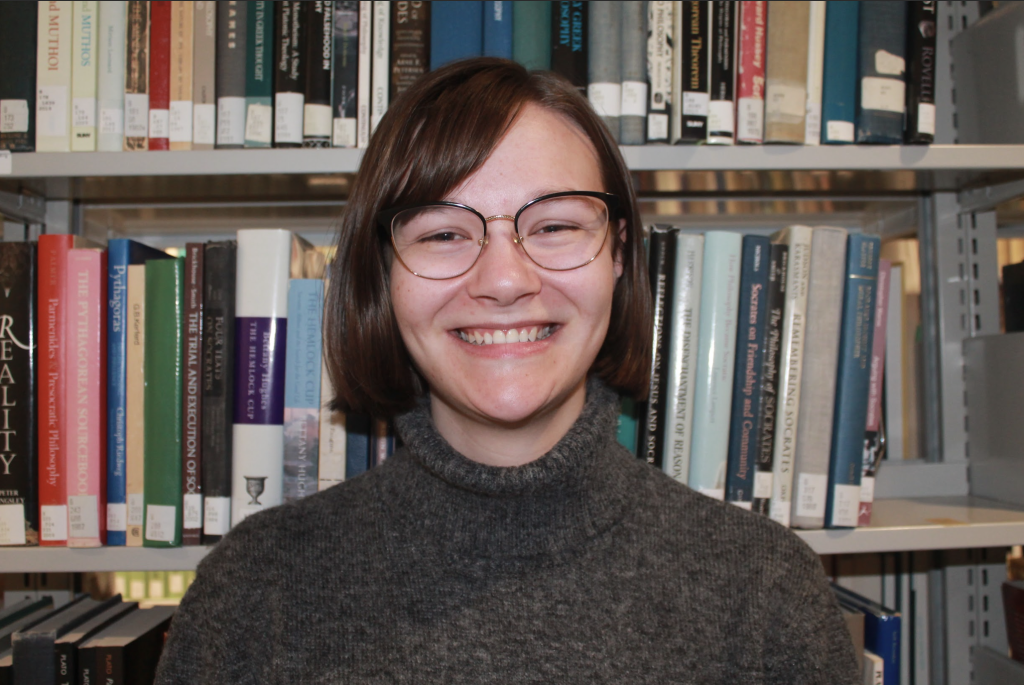 Maddie Geary
Maddie Geary
“Northanger Abbey: Jane Austen's Anticipation of Modern Critical Theory"
Reader-response theory and psychological criticism might be thought of as a 20th-century literary theory. However, Jane Austen was putting primary concepts to work in her Regency era texts. This analysis of Northanger Abbey reveals how Austen deftly manipulates reader response and anticipates important understandings of psychological theory in this supposedly simple romance.
Alison Henderson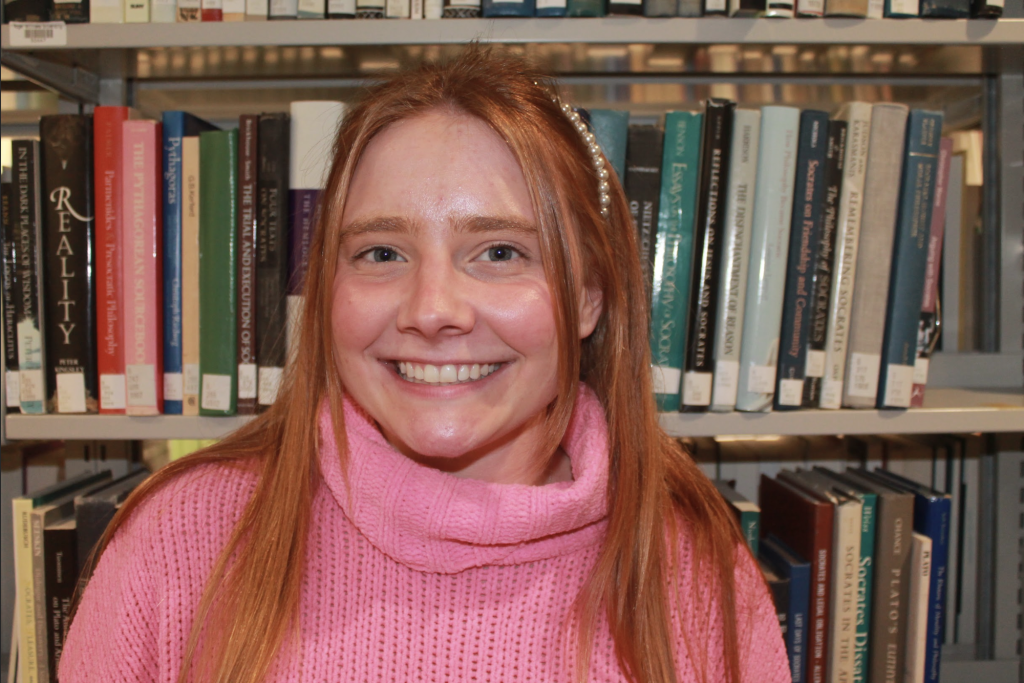
“Employing Character: Jane Austen and the Reading Woman"
In Jane Austen’s novel Northanger Abbey characters embody ideas about the importance of reading diverse literary genres. Specifically, her Innovative use of character reveals the value of women's reading in different genres for their own moral development, indirect reaction against traditional gender roles of Austen’s time.

Sydney J. Lauer
“As She Fills Her Dreams: Nineteenth Century Women Poets Reclaiming Agency with the Sonnet"
Until the Victorian era, the sonnet form and been primarily associated with elite male poets. However, the Victorian women poets Elizabeth Barrett Browning, Christina Rossetti, and Amy Levy radically redefined co-opted this traditional form to amplify the issues and perspectives of Victorian women writers despite patriarchal attempts to silence them.
Nick Ouellette
“Michelle Cliff's Abeng: Culturally Responsive Teaching in Context"
This paper analyzes how Cliff’s Abeng demonstrates the engaged learning principles in the classroom setting. Why would you want to learn something you have no interest in? Students' connections to what they are learning are incredibly important. Students need a reason to feel connected in order to learn well. Abeng’s text reveals the damage that can occur when this connection is missing.
Jacob Mich ael Rodrigues
ael Rodrigues
“The Relationship Between Art and The Artist: A Biographical Revelation of Oscar Wilde Through His Work"
Although Oscar Wilde and Sigmund Freud are rarely discussed together, this paper uses key concepts from Freudian theory to explore connections between Wilde’s theories of aestheticism and his complicated relationship to several events in his own life.
Parker L. Schwartz 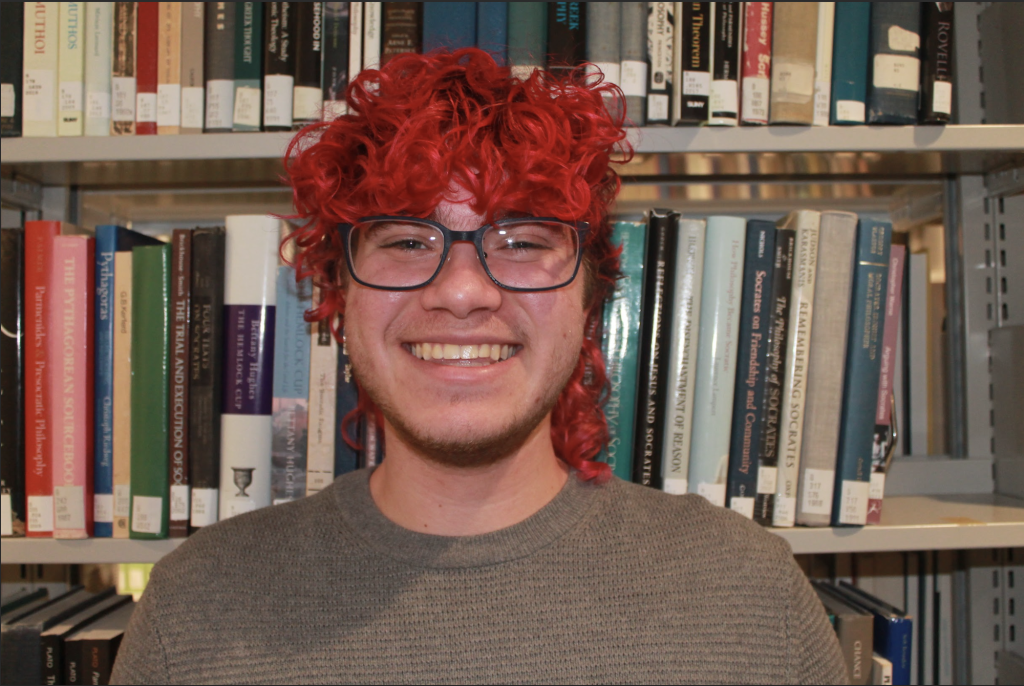
“Some Other Where": Amy Levy's Poetics of a Radical Queer Identity"
As a queer woman in Victorian England Amy Levy (1861-1889) exhibits both a strong portrayal of queer Identity and an understanding of Victorian culture’s deeply heteronormative biases. This strong portrayal is still often invisible to 21st century readers because of Levy’s deft use of coding. This thesis exposes her skill in crafting settings, implied context, ambiguous pronouns, and subtle undermining of heterosexual expectations. Reclaiming Levy’s deft portrayal of queer own identity is important for both literary scholars and everyday readers because it demonstrates that these identities are not new, while also highlighting the persistent historical struggle to represent gender identity from within cultures actively attempting to silence those identities.
Where’s Ideology? Analyzing Popular Culture– Fall 2021
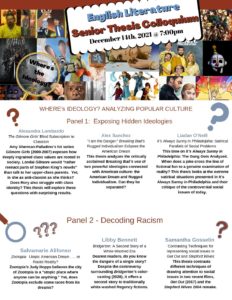
 Alexandra Lombardo
Alexandra Lombardo
“The Gilmore Girls’ Blind Subscription to Classism”
Amy Sherman-Palladino’s hit series Gilmore Girls (2000-2007) exposes how deeply ingrained class values are rooted in society. Lorelai Gilmore would “rather reenact parts of Stephen King’s novels” than talk to her upper-class parents. Yet, is she as anti-classist as she thinks? Does Rory also struggle with class identity? This thesis will explore these questions with surprising results.
 Alex Sanchez
Alex Sanchez
“I am the Danger:” Breaking Bad’s Rugged Individualism Eclipses the American Dream”
This thesis analyzes the critically acclaimed Breaking Bad’s use of two powerful ideologies connected with American culture: the American Dream and Rugged Individualism. Can they be separated?
 Liaden O’Neil
Liaden O’Neil
“It’s Always Sunny in Philadelphia: Satirical Parallels of Social Problems”
This time on It’s Always Sunny in Philadelphia: The Gang Gets Analyzed. When does a joke cross the line of fictional fun to a genuine examination of reality? This thesis looks at the extreme satirical situations presented in It’s Always Sunny in Philadelphia and their critique of the controversial social issues of today.
 Salvamarie Alifonso
Salvamarie Alifonso
“Zootopia: Utopic American Dream . . . or Racist Reality?”
Zootopia’s Judy Hopps believes the city of Zootopia is a “utopic place where anyone can be anything.” Yet, does Zootopia exclude some races from its dreams?
 Libby Bennett
Libby Bennett
“Bridgerton: A Second Story of a White-Washed Era”
Dearest readers, do you know the dangers of a single story? Despite the controversy surrounding Bridgerton’s color- casting (2020), it offers a second story to traditionally white-washed Regency fictions.
 Samantha Gosselin
Samantha Gosselin
“Contrasting Techniques for representing social issues in Get Out and Stepford Wives”
This thesis contrasts different techniques of drawing attention to social issues in two recent films, Get Out (2017) and the Stepford Wives 2004 remake.
 Ari Massos
Ari Massos
“Jujutsu Kaisen Akutami’s Radical Evolution of Shōnen Anime Protagonists”
“I don’t give a damn about men this or women that” — This thesis examines the evolution of female representation (with or without an LGBT subtext) within the Shonen anime genre through the protagonists portrayed in Gege Akutami’s series Jujutsu Kaisen (2018-Present).
 Hailey Reed
Hailey Reed
“Fight Like a Girl?: A Feminist Analysis of Game of Thrones”
-“Woman? Is that meant to insult me?” (Daenerys Targaryen) -There is much conversation about whether or not the hit series Game of Thrones is a patriarchal or feminist text. This thesis will analyze the ascent of the main female protagonists in order to find an answer.
 Kara Sylvia
Kara Sylvia
“Attacks on Japanese History and Nordic Myths in Hajime Isayama’s Attack on Titan”
What does Japanese history or Norse mythology have in common with Attack on Titan? (2013-Present). This thesis will closely analyze both sources as they inform the primary message of Hajime Isayama’s award- winning anime series.
 Amy Martin
Amy Martin
“I Was Afraid You’d Lost Your Way. But You Found It Again:” Redemption Arcs of “Flawed” Characters in Avatar: The Last Airbender, She-Ra and the Princesses of Power, and Infinity Train”
Redemption is not just limited to Jesus. While the term “redemption arc” has only recently been introduced by 21st century fan culture, it appears in a number of shows, particularly animated ones. Avatar: The Last Airbender, She-Ra and the Princesses of Power, and Infinity Train all portray key factors common to redemption arcs, including the importance of relationships, and a new conception of character “flaws.”
 Amanda C. Vesey
Amanda C. Vesey
“Don’t Hold It Against Us”: An Appearance and Reality Analysis of Five Nights at Freddy’s: Sister Location”
Yes, I did write a fancy-schmancy thesis about FNaF, that silly horror game series. I also had the audacity to compare it with Shakespeare. Trust me — I know it sounds silly, but if you hear me out, I might just convince you that beneath such appearances lies a more interesting reality.
 Olivia Dell Isola
Olivia Dell Isola
“Storytelling Through Taylor Swift’s Folklore”
Taylor Swift redefines the traditional definition of “folklore” by inviting her listeners to rewrite her stories and pass them down. A close reading from a trilogy of songs within Swift’s, Folklore, reveals the richness of the album’s complexity as it transcends from “mere” popular culture to high culture.
American Literature of the 1950s – Fall 2020
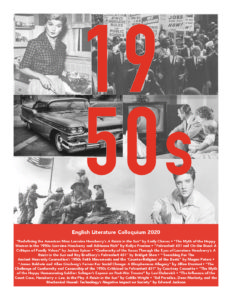
 Courtney Caouette
Courtney Caouette
“The Challenge of Conformity and Censorship of the 1950s Criticized in Fahrenheit 451”
We often hear the phrase, “Ignorance is bliss.” Ray Bradbury disagrees. Fahrenheit 451 presents several characters who challenge the action of blindly following social norms. In the beginning of the novel, for example, Guy Montag is a strict rule-following fireman who participates in enforcing censorship by burning books. By the end of the novel, he has become a free thinker who wants to read books and live with like-minded people who value literature. This transformation mirrors the evolution of the conservative 1950s to the counterculture that follows.
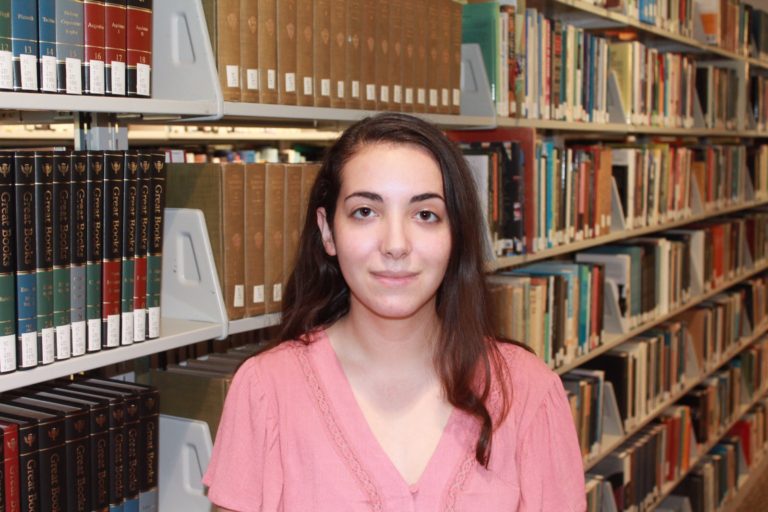 Emily Chaves
Emily Chaves
“Redefining the American Man: Lorraine Hansberry’s A Raisin in the Sun”
Lorraine Hansberry is a master at creating strong female characters, but what about her male characters? A Raisin in the Sun features a typical modern American male, Walter Younger, who is not as tough and independent as he would like to believe. Interestingly, Hansberry correlates the gradual evolution of Walter’s manhood with the dedication and strength of the women around him.
 Jillian Damiani
Jillian Damiani
“James Baldwin and Allen Ginsberg’s Fervor For Social Change: Blasphemous Allegories”
Through examining 1950s American culture and literature, two writers are decidedly intertwined through intellect and influence. Civil rights activist James Baldwin and far-out Beatnik Allen Ginsberg are comparable literary figures: both successfully swayed public opinion by utilizing the function of religiosity. Both voiced their dissent in poetry, prose, or essays with a peculiar kind of secular fervor. Ginsberg and Baldwin shied away from the traditional religious circles of their upbringings—Judaism and Christianity—and replaced that intellectual space with doctrines of their own design. Ginsberg and Baldwin used social change as means of appealing to mass audiences; their work functions as structured religions do, and the two writers became activists as well as secular messiah-figures.
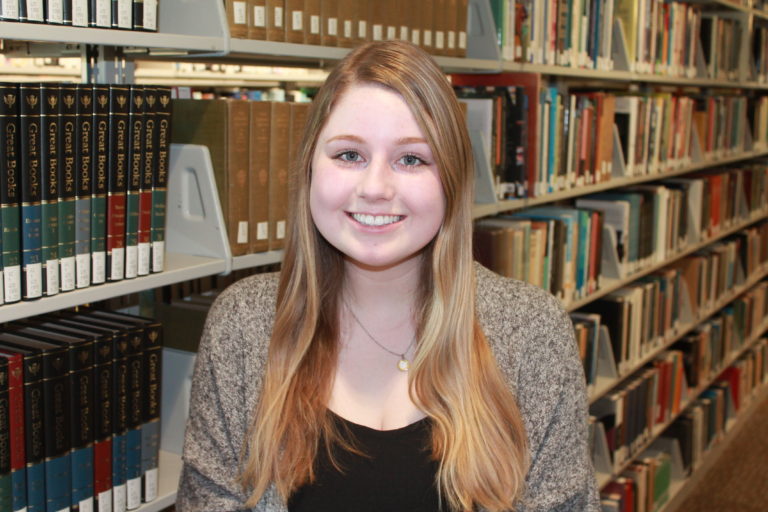 Lexi Dubovick
Lexi Dubovick
“The Myth of the Happy Homecoming Soldier: J.D. Salinger’s Exposé on Post-War Trauma”
In the 1950s, the majority of the American population was still high on its WWII victory. However, a dark counter-culture lay beneath this surface cheer. Many soldiers returned home with painful emotional and mental trauma due to their horrific war experiences that typical American citizens couldn’t fathom. These men were expected to embrace the identity of war hero, and many suffered silently. In J.D. Salinger’s “For Esmé—with Love and Squalor” and “A Perfect Day for Bananafish,” Salinger paints the picture of WWII soldiers struggling to readjust to domestic life in 1950s America, exploring the hidden reality of war trauma on American men.
 Eddy Jackson
Eddy Jackson
“Dean Moriarty, Sal Paradise, and the Mechanical Hound: Technology’s Negative Impact on Society”
On the Road by Jack Kerouac provides a view into the 1950s, a time when technology is in the sweet spot of promising development, which explains this decade’s positive attitude toward technology. However, Ray Bradbury provides us with a less familiar view into the 1950s attitude towards technology. Fahrenheit 451 imagines a dystopian future society where technology is used to oppress ideas and citizens. The contrast of these two novels reflects a conflict regarding technology that is still with us today.
 Megan Peters
Megan Peters
“Searching For ‘The Ancient Heavenly Connection’: 1950s Faith Movements and the ‘Counter-Religion’ of the Beats”
The 1950s are often hailed as the pinnacle of American religiosity. Although Christianity dominated the country’s religious landscape, a “counter-religion” also emerged, led by a group of poets and writers known as the “Beats,” who placed emphasis on decidedly un-Christian practices: sex, drugs, and travel. Yet their literary works, which came to define their beliefs system, contain evidence of a deep spirituality. This thesis examines the fundamental beliefs and practices of this unique brand of American religion through two of the best-known works of the Beat generation: Jack Kerouac’s On the Road and Allen Ginsberg’s Howl.
 Kailyn Preston
Kailyn Preston
“The Myth of the Happy Woman in the 1950s: Lorraine Hansberry and Adrienne Rich”
Second-wave feminism was a period of feminist activity in the United States that began in the early 1960s. Despite the stereotypical stylish, happy, pearl-wearing Mom who offers advice from the kitchen, many women during this time period were discontent with their lives. Both Lorraine Hansberry’s A Raisin in the Sun and Adrienne Rich’s poetry confront the 1950s “happy woman” as a myth.
 Joshua Spicer
Joshua Spicer
“Fahrenheit 451 and On the Road: The Critique of Family Values”
Sitcoms such as Leave it to Beaver and The Adventures of Ozzie and Harriet glorify the social structures and family values of the 1950s. However, two majors works of the period, however — Fahrenheit 451 and On the Road — radically represent a growing resentment towards traditional 1950s family values.
 Bridget Shea
Bridget Shea
“Conformity of the Sexes Through the Eyes of Lorraine Hansberry’s A Raisin In the Sun and Ray Bradbury’s Fahrenheit 451”
Although television portrayal of 1950s culture often features a surprising amount of conformity, novels of the period reveal thoughtful confrontations to cultural norms. For example, Fahrenheit 451’s protagonist Guy Montag is a confused government worker living a life initially blind to the negative impacts of his actions. His growing realization, however, correlates directly with his growing nonconformity. Likewise, A Raisin in the Sun portrays each member of the Younger family as they struggle with conformity to strict gender and family roles.
 Caitlin Wright
Caitlin Wright
“The Influence of the Court Case, Hansberry v. Lee, On the Play, A Raisin in the Sun”
The racial discrimination and inequality seen in the court case Hansberry v. Lee (1940) had a significant impact on life of the famous author Lorraine Hansberry. Her play, A Raisin in the Sun, sheds light on some of the challenges and feelings that her family faced during the trial. The play thus reflects 1950s societal and racial issues, both daunting and hopeful.
Jane Austen and Jerry Seinfeld Walk into a Bar: Readings in Cultural Theory and Popular Culture – Fall 2019

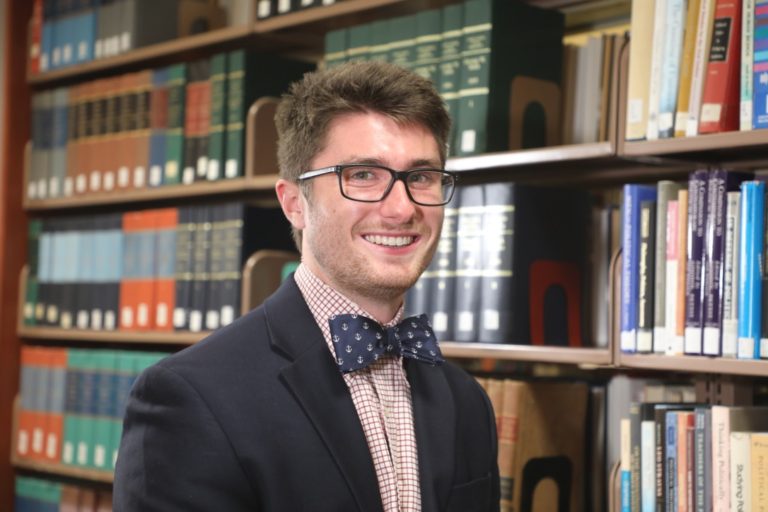 Garrett Bolton
Garrett Bolton
A Dirt Bag’s American Dream: An Ideological Analysis of Rugged Individualism in Free Solo
This thesis explores the 2018 People’s Choice Award winning documentary Free Solo’s treatment of the traditional American dream as lived by one of America’s greatest athletes, Alex Honnold. Does Honnold’s version of Rugged Individualism suggest a new (or old) revision of the American Dream?
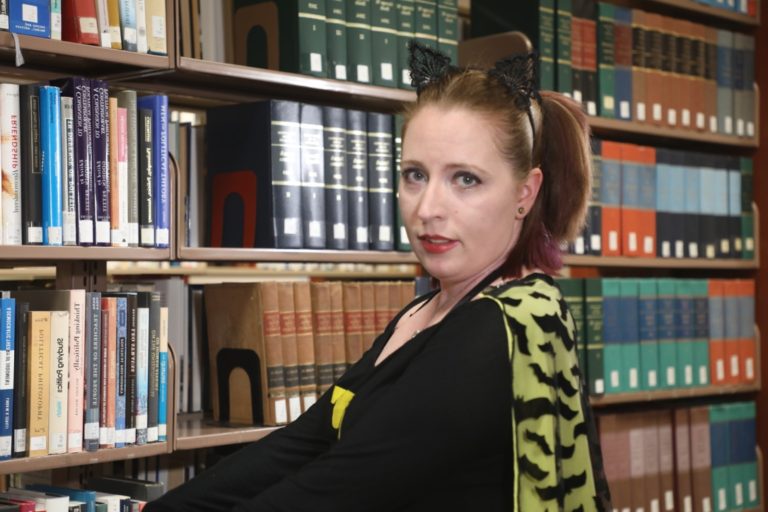 Jennifer Bryan
Jennifer Bryan
The Dark Knight of Morality vs. The Clown Prince of Crime
Director Christopher Nolan’s 2008 film,The Dark Knight, exposes the imbalance between the legal system and a code of moral justice through the portrayal of its characters, especially Harvey Dent, the Joker, and Batman. Because the Joker’s taunts against the Batman seem to contain elements of truth, the movie creates suspense as it explores this imbalance.
 Kayla Fuller
Kayla Fuller
“A Man’s (Wo)man:” A Gender Role Critique of Seinfeld’s Elaine and Susan
Seinfeld’s Elaine is often lauded as a “feminist icon,” but what does that mean? And is she the only Seinfeld character who has feminist tendencies? A close feminist reading of this series examines how its female characters break traditional gender roles and what this means for Seinfeld as a whole.
 Rachel Gover
Rachel Gover
Flirting with Intolerance in Comedians in Cars Getting Coffee
“Trump is the first blonde president, and absolutely no one’s giving him any credit.” —Should comedy hold hands in public with social critique? This close analysis of Seinfield’s Comedians in Cars Getting Coffee (2012) will examine this question as a subtext running throughout the series.
 Taylor Hasseltine
Taylor Hasseltine
“I Had no Idea Who I was Dealing with:” Distinguishing Components of True Crime
By analyzing three different docuseries—JonBenet Ramsey, The Ted Bundy Tapes, and The Disappearance of Madeleine McCaan—this thesis identifies previously unidentified subcategories within the True Crime genre: Profile True Crime (PTC) and Investigatory True Crime (ITC).
 Chloë Knopf
Chloë Knopf
“You’d Be the First Person in the History of the World:” Inescapable Ideology in The Master
Paul Thomas Anderson’s sophisticated portrait of postwar America is often referred to as an exposé of Scientology. It is much more than that, however. Anderson’s film articulates a bold proposition: even those who believe they are free from any “master” ideology remain ensnared, with or without their conscious knowledge.
 Julia Pina
Julia Pina
Is Austen’s Emma Clueless?
Popular culture is only good for entertainment, right? — As if! — This close comparison of ideology and satire in Jane Austen’s Emma and its 20th-century rendition—Amy Heckerling’s Clueless—reveals the depths of Clueless’s mastery.
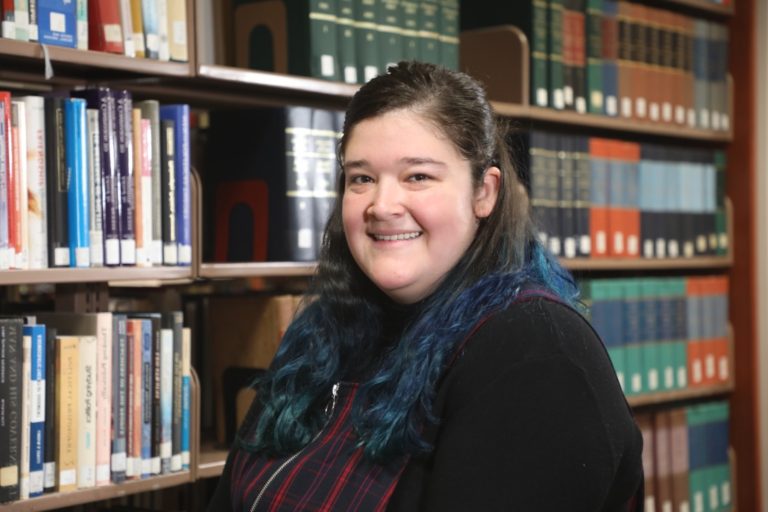 Jeannie Reyes
Jeannie Reyes
“And the Nicest Part of all, Val, I [Don’t] Look Just Like You!:” Unmasking the Differences Between Black Mirror and The Twilight Zone
Although your friends might tell you that Black Mirror is “just like The Twilight Zone, except it’s more about technology,” in fact, the two series are significantly and startlingly different.
 Michael Sannicandro
Michael Sannicandro
Born to Run as a Concept Album: Running Down the American Dream
Bruce Springsteen’s album Born to Run (1975) is often referred to as a “narrative.” Despite this common description, however, there is almost no scholarly research on its narrative structure. This paper will provide a close reading of the album’s lyrics to reveal previously unexplored aspects of its narrative structure.
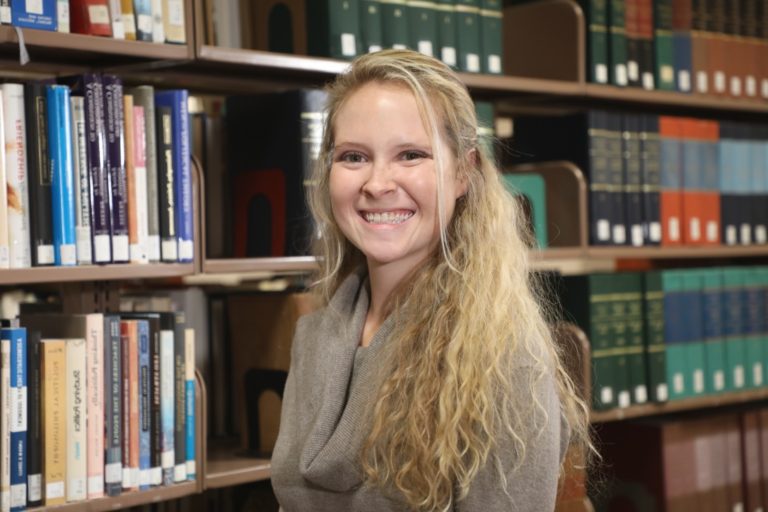 Riley Spillane
Riley Spillane
“Every Time a Targaryen is Born, the Gods Flip a Coin:” The Patriarchal Flip in Game of Thrones
[Spoiler alert] Despite Game of Thrones’ plethora of strong women who evolve as leaders, ultimately a male, not a female, ascends the Iron Throne. Does this choice mean that Game of Thrones is a patriarchal text? Or, does the plethora of powerful females constitute a feminist text? Through close analysis of Daenerys’ evolution, this thesis will help to answer these questions.
The Female Voice in Literature – Fall 2018
 Gabrielle Barnes
Gabrielle Barnes
“Lead Us Not Into Temptation and Deliver Us From the Patriarchy: Biblical Appropriation of the Female Voice”
This thesis traces eerie parallels between the historical portrayal of Mary Magdalene in biblical history and the characters of Moira and Offred in Margaret Atwood’s The Handmaid’s Tale. An analysis of the portrayal of women in both texts exemplifies the use of the patriarchal weaponization of the Bible to marginalize, objectify, distort, and/or silence the female voice.
 Vanessa Dos Anjos
Vanessa Dos Anjos
“Hermione, a Modern-day Athena: Friendships in Harry Potter and Homer’s Epics”
Homer’s Ancient Greek goddess Athena wields her considerable intellectual prowess, courage and loyalty to protect and guide her friend Odysseus throughout Homer’s epics, just as the modern witch Hermione weaponizes similar qualities to protect and guide her friend Harry Potter in J. K. Rowling’s Harry Potter book series. The evolution of these male-female friendships in literature showcases the development of multi-dimensional females as trusted heroic partners.
 Jenna Noell
Jenna Noell
“’There Could Be No Doubt of His Sex:’ Gender Fluidity in Virginia Woolf’s Orlando”
Throughout A Room of One’s Own, To the Lighthouse and Orlando: A Biography, Virginia Woolf explores the limitations of traditional Western gender norms by radically positing the universality and normality of androgyny, sexuality, and gender fluidity.
 Sam Painter
Sam Painter
“’Power in a Woman’s Wit and Will:’ Unmasking Feminism in Alcott’s Behind a Mask.”
Although many people imagine Louisa May Alcott as the restrained, moral writer of children’s books such as Little Women, few know that she also wrote thrillers under a pseudonym. Behind a Mask; or A Woman’s Power is a case in point. Its sensational story of disguise and stratagem hints lightly at the occult, while skillfully masking feminist empowerment beneath traditionally gendered behaviors.
 Samantha Rocca
Samantha Rocca
“Sisterhood of the Traveling Fan: The Importance of Intimacy in Lisa See’s Snowflower and the Secret Fan”
Lisa See’s Snow Flower and the Secret Fan tells the story of the narrator, Lily’s life from childhood to adulthood in Qing Dynasty China, focusing primarily on her relationship with her laotong Snow Flower.
 Emily Stoeppel
Emily Stoeppel
“An Evolutionary Redefinition of the Education of Women: Jane Eyre and Hermione Granger and the Influence of the Female Voice”
The evolutionary shift from the portrayal of Charlotte Brontë’s Jane Eyre in 1847 to J. K. Rowling’s Hermione Granger in 1997 reflects the change from an educational system that molds passive young women to one that frees females to pursue their own independence.
American Literature of the 1960s: English Literature Senior Thesis Colloquium - November 29, 2017
Colloquium Poster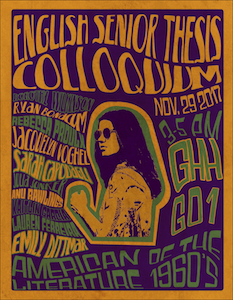 (click image for full-size poster)
(click image for full-size poster)
Faculty Director James Tackach, Ph.D.
James Tackach, Ph.D.
 Ryan Bonacum
Ryan Bonacum
“Generation Gap in 1960s American Literature: Revolutionary Road & Sticks and Bones”
American literature of the 1960s such as Richard Yates’ Revolutionary Road and David Rabe’s Sticks and Bones portrays the generation gap through the deterioration and failure of father and son relationships in American society. Yates anticipated the generation gap through the relationship of Earl and Frank Wheeler, which suffered because of the generational shift in values regarding manhood, hierarchy, and employment. Likewise, Rabe exaggerated the portrayal of the “perfect” American family in order to reveal the deterioration of Ozzie and Dave’s relationship, largely as a result of their opposing perspectives on the Vietnam War. The resentment and contempt which developed between these literary fathers and sons on account of their opposing values paralleled the lack of understanding which defined the generation gap of the 1960s.
 Sarah Capodagli
Sarah Capodagli
"The Continuation of Victorian Ideologies in 1950s and 1960s American Literature"
The Victorian Era was a period in England that formally followed the reign of Queen Victoria from 1837 to 1901; however, the era is not so rigidly set. 1960s America experienced similar female oppressions. This analysis of Sylvia Plath's The Bell Jar and Adrienne Rich's "Aunt Jennifer's Tigers" explores the similarities between the two eras and highlights the detrimental effects of a patriarchal culture.
 Emily Dittmar
Emily Dittmar
"The Rainbow Effect: How the Fight for Civil Rights Birthed a 1960’s Literary Spectrum"
This thesis focuses on four figureheads of the 1960's Civil Rights Movement whose writings and activism shaped American societal views of racial equity: Dr. Martin Luther King Jr., Malcolm X, James Baldwin, and Anne Moody. Each individual's approach to the Movement, as well as public perception of them (ex. MLK as a "lawful good" and Malcolm X as an opposite, "chaotic evil") are discussed and fleshed out in more detail, providing a combination of resources to humanize them and avoid simplifying their approaches.
 Lauren Ferreira
Lauren Ferreira
"The Dramatization of Betty Friedan’s Idea of the Feminine Mystique in Richard Yates’ Revolutionary Road”
In the American post-war 1950s, most people were looking for life to get back to normal: men getting jobs in the city and women taking care of the children and the suburban household. This picture-perfect lifestyle was the foundation of the American Dream that everyone was supposed to admire and strive for, and they expected to feel satisfied with life once they achieved its standards of living. However, many women who aspired to be the perfect housewife and mother, expecting to achieve lasting fulfillment and happiness, found themselves feeling just the opposite. This feeling that women found themselves experiencing when working towards the perfect life and falling short came to be known by researcher Betty Friedan as “the feminine mystique," exemplified in the character April Wheeler in Richard Yates' novel Revolutionary Road.
 Kaitlin Garcia
Kaitlin Garcia
“How did we ever get into this strange little dream world”: Conforming to the Nuclear Family Model in Yates’s Revolutionary Road and Plath’s The Bell Jar
While many view the 1950s as a pleasant decade in American history when middle class families lived happily in their suburban homes, this image of the time period fails to acknowledge the pressure people felt to fit this supposedly perfect family model. Writers of the 1960s, Richard Yates and Sylvia Plath, illustrate that people had to conform to the nuclear family structure in their respective novels Revolutionary Road and The Bell Jar. Even though their characters criticize the suburban family model, they ultimately must conform, or face the fatal consequences of nonconformity.
 Julia Junker
Julia Junker
"June Cleaver Who?: The Deterioration of Domesticity in Richard Yates’s Revolutionary Road and Sylvia Plath’s The Bell Jar”
Many people reflect on the 1950s as one of the “golden times" in America. Television shows such as Leave it to Beaver and The Adventures of Ozzie and Harriet, as well as the media, magazines, and advertisements, all propagated the concept of the nuclear family and a life of domesticity in the quaint suburbs. However, analyzing the 1960s works of Richard Yates and Sylvia Plath shows that this lifestyle was not all it was believed to be. Rather, Yates and Plath point to domestic life as a cause of the mental and emotional breakdowns of countless American women in the 1960s, instead of leading a life of fulfillment and happiness they had been practically guaranteed.  Rebecca Proulx
Rebecca Proulx
“‘Rubbing the Flies Out of Our Eyes: Grasping the Elusive Postmodern War Narrative”
Joseph Heller set a strong precedent for the postmodern war narrative with his classic Catch-22. Utilizing the key rhetorical tools of the nonlinear narrative structure, dark humor, and blunt diction to portray the chaos of war and coping strategies of the soldiers, his story became transcendent to readers and war writers beyond the World War II era. Tim O' Brien in his narrative If I Die in a Combat Zone, Box Me Up and Ship Me Home emulates these same rhetorical tools Heller made famous to describe own experience in Vietnam. Though writers of vastly different wars, both masterfully manipulate these tools tell a similar message: the true enemy is not who they were sent to fight, but the corrupt military entities forcing them to be there.
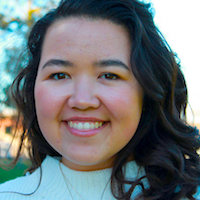 Anu Rawlings
Anu Rawlings
"The Hopeless Emptiness: Women’s Mental Health Care in Sylvia Plath’s The Bell Jar and Richard Yates’s Revolutionary Road"
Although their experiences both converge and diverge at different points, both of the female protagonists in The Bell Jar (Esther Greenwood) and Revolutionary Road (April Wheeler) depict a near-fatal or fatal deterioration into depression based inadequate psychological care. While the lives of these two fifties protagonists are fictional, the message about the importance of understanding female mental illness outside patriarchal constructs is indisputably real.
 Jacquelyn Voghel
Jacquelyn Voghel
“An Absence of Sisterhood: Feminism Without Movement and Esther Greenwood’s Descent into Despair in Sylvia Plath’s The Bell Jar”
In Sylvia Plath's semi-autobiographical novel The Bell Jar, protagonist Esther Greenwood experiences profound depression that stems from a lack of female connections as she comes of age during the 1950s. Without access to a significant feminist movement, which would not arise until the 1960s, Esther has difficulty connecting with other women, either due to their perceived adherence to patriarchal values or, at times, her own internalized misogyny. Isolated by the patriarchal landscape of the 1950s, Esther's lack of female connections exacerbate her depression, culminating in her breakdown.
 Dorothy Wilkinson
Dorothy Wilkinson
"Paved Paradise and Pushed to Depression?: The Role of Nature upon Anxiety and Depression in The Bell Jar"
While many audiences may read Sylvia Plath's The Bell Jar and see a critique of feminism in the 1950s and 60s, there is a larger, subversive narrative about the effects of nature on the main character, Esther Greenwood. A close reading of The Bell Jar reveals that Esther is suffering from a lack of the natural world as she navigates the concrete jungle of New York City, which subsequently exacerbates her depression and disconnect from reality, and ultimately leads her to try to take her own life.
10 Things You Don't Know About Jane Austen: English Literature Senior Thesis Colloquium - December 15, 2016
Colloquium Poster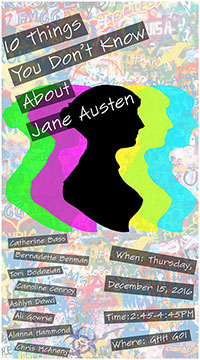
(click image for full-size poster)
Faculty Director
Margaret Case, Ph.D
PANEL 1: Does Jane Austen Ruin Romance?
 Catherine Bass
Catherine Bass
“First Comes Love, then comes Marriage” Or Not?: Revising Romantic Pre-Conceptions in Sense & Sensibility
Marianne Dashwood’s romance with John Willoughby, followed by her subsequent marriage to Colonel Brandon in Sense & Sensibility has perplexed many readers since the novel's original publication. Is Marianne giving up on her ideals when she agrees to marry Colonel Brandon? Examining this novel’s relationship dynamics reveals that Sense and Sensibility isn’t a traditional romantic novel at all.

Alanna Hammond
Pride & Prejudice: A Tolerable Romance
Many people view Jane Austen’s Pride and Prejudice as primarily a “romance novel” in the modern sense of that phrase – in which two lovers overcome obstacles to reach a happy ending culminating in marriage. I argue that this view overlooks Austen’s skillful re-direction of the romance impulse. Specifically, Pride and Prejudice highlights the reality of what marriage means for 19th-century women.
PANEL 2: How Progressive Is Jane Austen?
 Ashlyn Dowd
Ashlyn Dowd
What’s Money Got to Do with it?: Marriage Equality in Pride and Prejudice
Austen scholar Edward Copeland argues that money is the primary factor hidden behind the marriages in Austen’s novels, including Pride and Prejudice. I argue the opposite. The slow recognition and appreciation of equality is what actually draws Elizabeth Bennet and Fitzwilliam Darcy together. Money is not the primary factor. Pride & Prejudice’s emphasis on equality (instead of money) matters because it reveals the remarkable proto-feminism of this nineteenth-century text.

Tori Bodozian
It’s NOT "Only Anne": Social Criticism in Jane Austen’s Persuasion
Jane Austen’s most overlooked novel, Persuasion, has often been interpreted by critics as both pessimistic and conservative. However, a close, historial reading reveals that Persuasion is actually Austen’s most overtly progressive novel in its criticism of marriage and social class.

Ali Gowrie
Catherine Morland: Northanger Abbey’s “Realistic Heroine
Many Austen critics have argued against Northanger Abbey’s Catherine Morland as a heroine. I argue instead that Catherine’s character flaws allow her to resist unrealistic expectations defined by other sentimental heroines of the time, break gender role expectations and establish a new type of realistic heroine.

Caroline Conroy
Fitting the “Big Bow-wow Strain” onto “Two Inches Wide of Ivory”: Jane Austen and Walter Scott’s Repurposing of the Gothic Novel
Despite the traditional view that Jane Austen and Walter Scott write radically different types of novels (the novel of manners and the historical novel, respectively), these two authors, in fact, have many important similarities. This thesis examines these shared similarities in Austen’s Northanger Abbey and Scott’s Waverley. Specifically, Austen and Scott both repurpose elements of the Gothic novel, which ultimately results in the development of Austen’s novel of manners and Scott’s historical novel. This comparison reveals that these similarities might be more significant than their differences.
PANEL 3: Is the Movie Ever as Good as the Book?
 Bernadette Benman
Bernadette Benman
Feminst Elements of Pride & Prejudice: Film and Text
It is a truth universally acknowledged among English Majors that the movie is never as good as the book. This might be especially true for Jane Austen’s novels, which contain a complex narrative irony. However, there are a few film adaptations, especially Director Joe Wright’s 2005 Pride and Prejudice, that capture on screen what some readers may have been unable to “see” in the book. Specifically, my close comparison of film and text will reveal both subtle and overt aspects of this novel’s proto-feminist values.

Chris McAneny
Swords as Sharp as Your Wits: Narrative Techniques and Regency Horror in Pride and Prejudice and Zombies
It is easy to dismiss Pride and Prejudice and Zombies (dir. Burr Steers; 2016) as superfluous and superficial. However, this recent film adaptation of Austen's classic novel does reflect some of the novel’s sophisticated techniques. Inserting zombies into Austen's regency period can actually shed light on Austen's subtle narrative strategies.
American Literature of the 1950s: English Literature Senior Thesis Colloquium - December 10-11, 2015
Colloquium Poster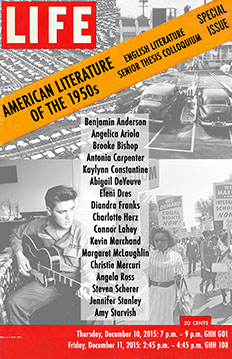
(click image for full-size poster) Faculty Director
James Tackach, Ph.D.
Thursday, December 10, 2015: PANEL 1: Beneath the Surface of the “Silent Generation”
 Antonia Carpenter
Antonia Carpenter
“You’re All Just a Bunch of Phonies: Uncovering the Mask of Conformity in Fahrenheit 451, The Catcher in the Rye, and The Crucible”
Arthur Miller’s The Crucible, J.D. Salinger’s The Catcher in the Rye and Ray Bradbury’s Fahrenheit 451 are all written in the 1950s and all suggest harsh penalties for those who buck traditional social dynamics of conformity.
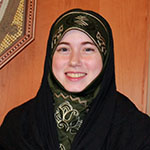
Kaylynn Constantine
"Escaping Disillusionment: The Tyrones’ and Guy Montag’s Struggle for Diversion through Illicit Activities”
Iconic 50s American literary texts Long Day’s Journey into Night and Fahrenheit 451 reflect a dissatisfaction with both conformity and the general cultural norms of their societies.

Abigail DeVeuve
"From Puritan Ministers to Futuristic Firemen: Alternate Settings as a Critique of the 1950s Norms in The Crucible and Fahrenheit 451”
The alternative settings of Arthur Miller’s play The Crucible (published in 1953 and set in 1692 Salem, Massachusetts) and Ray Bradbury’s science-fiction novel Fahrenheit 451 (published in 1953 and set in the distant future) actually provide a subversive critique of oppressive 1950s norms and values, especially conformity.

Jennifer Stanley
"Guy Montag and the Characters of Fahrenheit 451: Their Desire of the Impossible Escape from Dystopian Society”
Ray Bradbury’s Fahrenheit 451 equates 1950s technological advancement and censorship with stagnant dystopia based upon the blissful ignorance of knowledge and free thought, warning his readers (past and present) about a passive acceptance.
PANEL 2: The American Family in 1950s Literature
 Connor Lahey
Connor Lahey
“Holden Caulfield’s and Sal Paradise’s Relationship Failures Due to a Lack of Familial Connection”
Holden Caulfield from J.D. Salinger’s The Catcher in the Rye and Sal Paradise from Jack Kerouac’s On the Road both link dysfunctional family and peer dynamics to failed romantic relationships.

Brooke Bishop
"Changing the Family Dynamic: The Loss of a Child in The Catcher in the Rye and Long Day’s Journey into Night”
Holden Caulfield in J.D. Salinger’s The Catcher in the Rye and the Tyrone family in Eugene O'Neill’s Long Day’s Journey into Night both present dysfunctional family dynamics that feature the loss of a child.
PANEL 3: Critiquing the American Dream
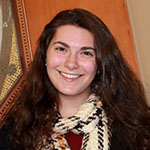 Angela Ross
Angela Ross
“‘The American Dream’: Mid-Twentieth Century Literature’s Attempts to Push Through Traditional American Boundaries As Seen in Long Day’s Journey into Night, The Catcher in the Rye, and the Works of Adrienne Rich”
The Catcher in the Rye’s Holden Caulfield, Long Day’s Journey into Night’s Tyrone Family, and Adrienne Rich’s many feminist protagonists all test and confront the stereotypical American Dream, suggesting ultimate unattainability.

Benjamin Anderson
“How Chasing Dreams, Society’s Standards, and Family Members Influence a Character’s Identity in 1950s American Literature”
This thesis explores positive and/or negative relationships to the American Dream in Lorraine Hansberry’s A Raisin in the Sun and Eugene O’Neill’s A Long Day’s Journey into Night.

Diandra Franks
“A 1950s Critique of the American Dream: Despised, Devastated, and Deferred”
J.D. Salinger’s The Catcher in the Rye, Eugene O’Neill’s Long Day’s Journey into Night, and Lorraine Hansberry’s A Raisin in the Sun, all critique the American Dream revealing hidden nightmares within the core ideals of that Dream.
Friday December 11, 2015: PANEL 1: Religion in 1950s American Literature
 Kevin Marchand
Kevin Marchand
“Religious Drama: Seeing Religion for What It Really Is Through the Lens of 1950s Drama”
Arthur Miller’s The Crucible, Lorraine Hansberry’s A Raisin in the Sun and Eugene O’Neill’s Long Day’s Journey into Night, all explore childish, primitive facets of religious belief, and make the case for a secular spirituality.
 Angelica Ariola
Angelica Ariola
“The Difference Between Two Mothers in 1950s American Drama: A Religious God and a False God”
Lorraine Hansberry’s A Raisin in the Sun and Eugene O’Neill’s Long Day’s Journey into Night both present very different versions of motherhood. However, despite the profound difference in the types of mothers portrayed, both plays reveal the same correlation between motherhood and religion.
 Maggie McLaughlin
Maggie McLaughlin
“Eugene O’Neill’s Long Day’s Journey into Night: A Milestone in Religious Skepticism.”
Eugene O'Neill's Long Day's Journey into Night provides evidence of the religious skepticism present in the fifties and represents religious controversy between the elder generation’s loss of religion, founded in trauma, and youthful anti-religious ideals.
PANEL 2: Women in 1950s American Literature
 Eleni Dres
Eleni Dres
“Brewing Up Feminism in the 1950s: Mary Tyrone’s and Beneatha Younger’s Stirring of the Pot”
Eugene O’Neill’s, Mary Tyrone, in Long Day’s Journey into Night and Lorraine Hansberry’s, Beneatha Younger, in A Raisin in the Sun, signal the social disobedience occurring in the 1950s and the readiness for a more liberating and understanding society for women.

Christie Mercuri
“‘That Pleasant Prison Dream’: America’s Poetic Revolt Against Marriage in the 1950s”
The Feminist poetry of Adrienne Rich and the Beat poetry of Gregory Corso both expose the truly suffocating nature of traditional marriage and domesticity in contrast to the iconic perfect family.

Amy Starvish
“Internalizing Eve: The Influence of Judeo-Christian Ideology on the Depiction of Women in Arthur Miller’s The Crucible”
The Crucible’s portrayal of women as an “evil of nature painted in fair colors” exemplifies the Judeo-Christian stigma against women.
PANEL 3: Nature in 1950s American Literature
 Steven Scherer
Steven Scherer
“The Longing for the Natural World in the Literature of the 1950s”
Arthur Miller, Lorraine Hansberry, and Ray Bradbury are not necessarily names associated with the environmental movement; however, The Crucible, A Raisin in the Sun, and Fahrenheit 451, respectively, discuss issues of conservation and preservation, and/or argue that more should be done to protect animals, plants, and trees.
 Carli Herz
Carli Herz
“Nature Deficit Disorder in 1950s Literature: Are Holden Caulfield and Guy Montag Suffering from a Lack of ‘Vitamin N’?”
Through the connection of character analysis, research in the field of psychology and eco-criticism, and historical context, my thesis is able to come to the conclusion that Holden Caulfield and Guy Montag represented what we now call Nature Deficit Disorder – and the general malaise of 1950s America’s relationship with the natural world.
Deconstructing the Popular: from Dawson's Creek to Facebook: English Literature Senior Thesis Colloquium - December 12, 2012
Colloquium Poster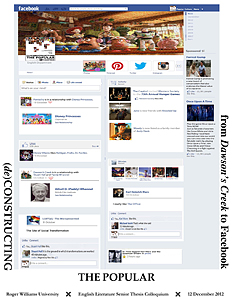
(click image for full-size poster)
(click here for printable program)Thesis Presenters
- Mallorey Blake
- Hailey Davis
- Samantha Duncan
- Laura Dzialo
- Michelle Lee
- Kate Marshall
- Emily Rann
- Danielle Reagan
- Tracy Smith
- Abigail Sprague
- Kayla Sweeney
- Kathrine Torres
- Sara Zatir
Faculty Director
Margaret Case, Ph.D.
Read Dr. Case's Opening Remarks
PANEL 1: Anime, Toys and Politics: Translating the Popular
 Katherine Torres
Katherine Torres
“From Apocalyptic Realism to Utopian Idealism: Illuminating Studio Ghibli's Transnational Resonance”
Japanese animation, known as “anime,” is one of the most rapidly expanding forms of visual popular culture. Studio Ghibli, arguably Japan’s most beloved anime production studio, is one of the most internationally successful producers of high quality anime films. The studio’s canonical films include Nausicaä of the Valley of the Wind (1984), Laputa: Castle in the Sky (1986), Princess Mononoke (1997) and Howl’s Moving Castle (2004). This thesis analyzes the ways in which these works, often marginalized as children’s fare, illuminate the ways in which the cultures of Japan and America coalesce. Also explored is the way in which the strong bond between Japanese and American culture may act as a motivating force for the creation of a globalized popular culture, one that is mukokuseki (i.e., without nationality).
 Michelle Lee
Michelle Lee
"Lotso Love is Missing in the Toy Story Series"
Hidden within the fun-filled plot of Pixar's Toy Story series (1995 - 2010) is a representation of family values riddled with what Karl Marx dubs "false consciousness." The first film in the series introduces the idea that children should treat toys as family. As the series continues, however, this message subtly changes. Toys are no longer viewed as family; instead, they become mere objects, or commodities. By Toy Story 3, the neglect the toys face becomes so intense that the series ultimately undermines family values.
 Mallorey Blake
Mallorey Blake
"I Love The Hunger Games: What Does that Mean?"
This thesis examines Suzanne Collin’s The Hunger Games trilogy (2008-2010) as a piece of popular culture that is more than mindless entertainment. Examining the different types of entertainment culture and societal oppressions depicted in this work reveals surprising similarities between the fictional world of Panem and our world today. Further, these similarities suggest that it is possible to read the dystopic Hunger Games as a warning tale. Ultimately, this thesis concludes that those who love this trilogy might ask themselves whether or not they noticed that it critiques the same culture of entertainment in which it participates.
PANEL 2: Radical Media: The Evolution of Popular Culture
 Tracy Smith
Tracy Smith
"A Transformation in Popular Culture Stereotypes: Changing Representations of the LGBTQQ Community"
Through an examination of various television shows and movies, this thesis presents both the positive and negative representations of the LGBTQQ community evolving within popular culture between the 1970s and the present. This social transformation – especially as it reveals itself in the treatment of stereotypes – analyzes both the resistance and perpetuation of LGBTQQ stereotypes in the culture at large.
 Abigail Sprague
Abigail Sprague
"Dawson’s Creek: Complexity vs. Didacticism in Youth Culture"
Kevin Williamson’s WB television series Dawson’s Creek (1998-2003) focuses on teenagers growing up in Capeside, Massachusetts. Although some critics might argue that this series exploits teen sexuality for the purpose of higher ratings, this thesis reveals that, in fact, Dawson’s Creek reflects important developmental aspects of its youth audience. Drawing on the work of Raymond Williams, Stuart Hall and Paddy Whannel, this close analysis of Dawson’s Creek reveals that far from exploiting teen sexuality, the show instead portrays teens involved in generating a complex understanding of their own psychological, emotional, and moral behavior.
 Laura Dzialo
Laura Dzialo
"Redefining the American Family: A Feminist Analysis of Juno and Knocked Up"
This thesis examines depictions of motherhood, marriage, and family in two 2007 films, Juno and Knocked Up. Both films initially seem to convey feminist ideals; however, a close examination reveals strains of patriarchal ideology beneath the feminism. The characters mock as well as adhere to patriarchal values and struggle to transcend patriarchal ideology; in fact, the patriarchal mindset is so pervasive that the characters cannot always effectually avoid it. Nonetheless, characters in both films do manage to propose significant redefinitions of the traditional American family structure.
 Kate Marshall
Kate Marshall
"Facebook Phenomenon: Becoming the ‘Authors’ of Our Own Selective Fiction"
Since its creation in 2004, Mark Zuckerberg's Facebook has become a part of our everyday lives. With over 500 million users, many might assume that Facebook is a fairly innocuous software tool, helping to bring global inclusiveness and immediate contact between friends and family. However, this analysis will reveal disturbing questions: Has Facebook allowed for more transparency within society; or, conversely, has it promoted an unhealthy tendency to create integrated multiple realities? Has Zuckerberg achieved his original goal to create "openness" or has he paradoxically allowed people to become authors of their own deceptively selective fictions?
PANEL 3: Reifying the American Dream
 Sara Zatir
Sara Zatir
"Time is Money, and Money is Life: A Marxist Analysis of In Time"
Cultural theorist Stuart Hall writes, “almost all cultural forms will be contradictory,” and the film In Time (2011) is no exception. In Time might seem merely to be an entertaining film about an unreal, futuristic world where time has been transformed into currency. However, close analysis reveals two shockingly contradictory ideologies present within this film: Marxism and the American Dream.
 Emily Rann
Emily Rann
"Forrest Gump: Promoting ‘Conservative Acceptance’"
Many critics categorize Forrest Gump as a conservative movie since it both subtly and overtly promotes conservative ideology. However, that assessment fails to answer important questions (e.g., if the movie is purely conservative, why was it extremely popular across the entire country? And why does Forrest fall in love with a liberal?) This analysis reveals that the promotion of conservatism is actually alloyed with the promotion of a liberal value of acceptance, resulting in the movie’s promotion of “conservative acceptance.
 Samantha Duncan
Samantha Duncan
"Mocking the American Dream?: An Ideological Analysis of The Office"
NBC's Emmy Award winning television series The Office (2005-present) depicts characters experiencing mundane, yet comical, work day scenarios. Although the show might seem to be a simple comedy about office life, this thesis reveals its strong motivating ideologies. In particular, The Office reveals contradictory cultural attitudes within capitalism's dominant ideology: The American Dream.
PANEL 4: Ideological Uses of Enchantment in Disney and Fairy Tales
 Danielle Reagan
Danielle Reagan
"Once Upon a Time: Breaking the Binary Between Fiction and Reality"
ABC’s television show Once Upon a Time (2011-present) blurs the distinction between fiction and reality, which is both the entertaining premise and the subtle yet powerful conceptual foundation of the show. Drawing on popular culture theory, Bruno Bettelheim and J.R.R. Tolkien’s definitions of fairytales/fantasy, the psychology of defense mechanisms, new critical close reading, and deconstructionism’s insights into false binaries, this thesis will argue that Once Upon a Time demonstrates a depth of complexity that transcends its ostensibly simple status as popular culture.
 Kayla Sweeney
Kayla Sweeney
"The Princess Fantasy: Does Disney Poison Consumer Culture?"
This thesis explores an important question in cultural studies: who bears the blame for harmful ideologies inherent in consumer culture? This thesis will use The Walt Disney Corporation's phenomenally popular princess product line (including eleven films and nearly 30,000 Disney Princess related products) as a case study. After identifying several potentially harmful patriarchal stereotypes in both the Disney films and even more disturbing patriarchal trends in its Disney Princess product line, this thesis will raise the issue of culpability for the proliferation of these oppressive stereotypes. Moreover, this analysis simultaneously reveals why and how audiences “buy into” culture.
 Hailey Davis
Hailey Davis
"Childhood Lessons of Evil: An Examination of Disney Villains"
This thesis uses three Disney animated villains to reveal that there exists intrinsic analytical value to sustained study of these characters despite the fact that they exist in the genre of children's media. Focusing primarily on The Great Mouse Detective's Professor Rattigan, The Hunchback of Notre Dame's Judge Frollo, and The Princess and the Frog's Dr. Facilier, this thesis will analyze important variations within the range of archetypal Disney villains to reveal the complexities that of their brands of "evil." This thesis concludes that Disney villains are neither flat nor formulaic; indeed, they have a great deal to teach both children and adult audiences.
Deconstructing the Popular: from Mordor to Jersey Shore: English Literature Senior Thesis Colloquium - May 10, 2012
Colloquium Poster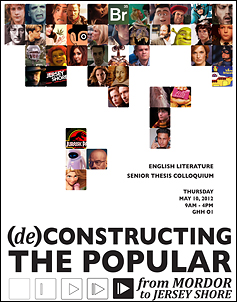
(click image for full-size poster)
(click here for printable program)
Thesis Presenters
- Ashley Aliengena
- Alexandra Artiano
- David Chapleau
- Cahrissa Dasso
- Kara DeAngelis
- Zachary Lyons
- Marguerite Meinzer
- Elizabeth Mullin
- Elizabeth Perreca
- Annie Rae
- Mary Rafferty
- Kristina Ragone
- Jessica Sasso
- Amanda Silva
- Laura St. Aubin
- Caitlin Studley
- Kristyn Wajsgras
- Kaleigh Wilson
- Jared Wolf
- Devin Zucker
Faculty Director
Margaret Case, Ph.D.
Read Dr. Case's Opening Remarks
PANEL 1: FALLACIES OF POPULAR CULTURE
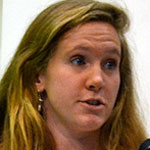 Annie Rae
Annie Rae
"Dissolving Barriers: The Beatles and Across the Universe"
In 2007, Universal Studios released the movie musical, Across The Universe, which pays tribute to the Beatles and culture of the 1960s. Many protested that the movie’s popular culture form was degrading the legendary work of the Beatles.This negative reaction, however, may have been a result of American society operating under the misunderstanding of the role of popular culture.This thesis argues first that Across the Universe is a relevant and appropriate medium for a tribute to the Beatles. It then uses this argument as a case study that attempts to shatter the mistaken ideology that analyzing popular culture has no academic value.
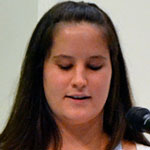 Elizabeth Mullin
Elizabeth Mullin
"‘The Pirates Don’t Eat the Tourists’: Jurassic Park and the Dangers of Frankenstein’s Creation"
This close analysis of Steven Spielberg’s Jurassic Park (USA, 1993) -- one of over a thousand different adaptations of Mary Shelley’s Frankenstein(1818) -- demonstrates that despite the many technological advances of the past two centuries, both texts follow very similar patterns in cautioning that potential disaster may arise from unchecked scientific experimentation. It is worth noting that despite nearly two hundred years of separation, the two texts raise almost the same questions in relation to the ethics of scientific progress.This thesis further notes that the social unease concerning scientific ethics reflected in both novels might explain the popularity of the Frankenstein story. If, as cultural theorist Stuart Hall suggests, "Popular culture is one of the sites where [the] struggle for and against a culture of the powerful is engaged," then the Frankenstein story might remain so popular because it engages its audiences in a relevant issue that has yet to be solved.
 Kara DeAngelis
Kara DeAngelis
"Convincing Matthew Arnold to Read Jodi Picoult: The Plain Truth about Popular Culture"
Is it possible to be both a work of mass culture and still meet the standards of quality set in place by elite cultural theorists such as Matthew Arnold and F. R. Leavis? Using Jodi Picoult’s novel Plain Truth (1999) as a case study, this paper will examine the recent push in higher education to study popular culture. It will address the fear that popular culture studies leads to "leveling" or watering down the quality of higher education. I will analyze both the novel and the Lifetime Television adaptation of this story to illustrate the potential value of mass culture while also making distinctions based on aesthetic quality. This analysis is based on cultural theorists ranging from Matthew Arnold to Michael Schudson in order to explode the cultural dichotomy between high and low culture.
 Marguerite Meinzer
Marguerite Meinzer
"Rubbernecking the Jersey Shore"
This thesis examines why Jersey Shore (2009-Present), MTV’s popular reality show, is so interesting to viewers despite the fact that many dislike the show. In order to understand why, it is crucial to study cultures featured in the show.Through this analysis, I have discovered the cast members place an emphasis on the culture of drinking alcohol, the culture of sex, and the culture of appearance. Examining these three cultures reveals imbedded interests: danger, violating social norms/taboos, and vicarious participation. Although there is much controversy over this show, it is evident that the show prompts much interest. Raymond Williams, a popular culture critic, would agree that studying these cultures helps viewers understand their own wider culture, which ultimately helps audience members better understand their society as a whole.
PANEL 2: ENVIRONMENTAL ALIENATION
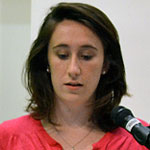 Elizabeth Perreca
Elizabeth Perreca
"Imploding False Consciousness and Igniting Praxis: A Marxist Analysis of WALL-E"
Disney Pixar’s WALL-E (USA, 2008) ostensibly presents itself as an innocent family film portraying the love between two robots,WALL-E and EVE. However, despite the seemingly innocent romance, WALL-E contains strong ideological components. Specifically, it attacks the consumerist impulse implicit within a capitalist ideology. Ultimately,WALL-E acts as the catalyst for political change, freeing humanity from the constraints of consumerist ideals. WALL-E also reveals humanity’s inability to partake in the Marxist concept of "praxis." Specifically,WALL-E rejects capitalistic ideals by reinstating the impetus for praxis within society. Upon humanity’s return to Earth they are able to reconnect with each other and nature, partake in meaningful labor, and rebuild a planet destroyed by consumer capitalism.
 Laura St. Aubin
Laura St. Aubin
"Christopher McCandless: Into the Wild's Marxist Martyr"
Director Sean Penn’s adaptation of John Krauker’s book Into the Wild (USA, 2007) tells the story of Christopher McCandless, who gives up all possessions and walks away from an upper middle class, dysfunctional family to go on a "great Alaskan adventure." Unfortunately, he is unable to survive in the wilds of Alaska and he dies a painful death. A close analysis of Chris’s relationship to the two most extreme ideologies of his life -- capitalism and romanticism -- will reveal what leads him to this situation. It will also explain how Chris’s deep transcendentalist yearnings bring him salvation from hypocrisy and the insidious corruption of material things, while routing him closer to humanity and human connectedness.
 Jessica Sasso
Jessica Sasso
"Seeking Balance: A Sustainability Framework Analysis of Into the Wild"
This thesis analyzes Into the Wild’s Christopher McCandless, a seemingly flawless Romantic who travels into the lost acres of Alaska. McCandless abandons society by latching onto the Romantic ideal that one must surround one’s self in nature to find truth beyond materialism. However, he disregards ideals that balance the Romantic equation.With no intention of returning to society, McCandless unwittingly embodies the hyper-individualist lifestyle from which he is trying to escape, ultimately leading to his death. Looking at McCandless through a lens of sustainability reveals the complicated interrelationships between Man and Nature.
PANEL 3: DECONSTRUCTING IDEOLOGIES
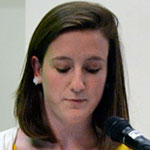 Caitlin M. Studley
Caitlin M. Studley
"‘I'm Finished!’: Yielding to Capitalist Ideology in There Will Be Blood"
Paul Thomas Anderson’s There Will Be Blood (USA, 2007), a loose retelling of Upton Sinclair’s Oil! (1927), explores the trials and tribulations of early 20th century oil tycoon Daniel Plainview. While Daniel’s powerful pronouncement "I’m finished!" in the closing scene of the film may present itself as little more than his declaration of victory over his chief competitor, a close analysis of Daniel’s character reveals this statement as the pinnacle of his unconscious submission to the ideology of capitalism, which ultimately destroys his personal relationships and leaves him with nothing other than his painfully acquired wealth—a seemingly useless accomplishment by the film’s end.This focus on Daniel provides new insight into the commonly critiqued and tense relationship between capitalism and religion present in this film.
 Devin Zucker
Devin Zucker
"Incommensurate Moralities: An Ideological Analysis of Breaking Bad"
By analyzing the complexities that arise between family values and traditional Judeo-Christian moral codes in AMC’s popular hit series Breaking Bad (2008-present), readers will realize why series protagonist Walter White is difficult to classify as a moral character. Upon discovering that he has terminal cancer,Walter begins to manufacture methamphetamine so that his family will be provided for after his death. His hard work and clear desire to provide for, protect, and guide his family seems to provide moral justification for his actions. However, by putting his family first he abandons traditional morality.This thesis will ultimately explain one reason for this show’s popularity by analyzing Walt’s incommensurate moral justifications through the lenses of both deontology and consequentialism.
 Kristyn Wajsgras
Kristyn Wajsgras
"Ticky Tacky Patriarchy: Feminist Chaos in Weeds"
In the Showtime series Weeds (2005-Present) the protagonist Nancy Botwin turns to trafficking marijuana in order to maintain a comfortable lifestyle for herself and her two sons after the death of her husband. Some viewers may view Nancy as a representation of an attempt to combine the role of mother and the role of working woman. In this sense, the show may seem to convey a feminist outlook. Nancy might appear to be a strong and independent woman doing the best she can for her family while also dealing with the struggle of running a business. However, this thesis will argue that this series not only represents "motherhood" and "business women" as mutually exclusive ideas, but also reinforces the patriarchal notion that chaos ensues when women escape patriarchal gender roles.
PANEL 4: RECONSTRUCTING IDEOLOGIES
 Kaleigh Wilson
Kaleigh Wilson
"‘How Do You Like Them Apples?’: Good Will Hunting’s Alternative Path to Success"
Lawrence Bender Productions’ Good Will Hunting (USA, 1997) might seem to be a feel-good love story, or perhaps even viewed as fleeting amusement because it is a work of popular culture. However, a close analysis of the movie indicates a carefully structured film designed to provide a gentle critique of the American Dream. In place of the American Dream, the film offers an alternative set of values, replacing materialism with emotional strength.
 Ashley Aliengena
Ashley Aliengena
"Justifying the Finale: Hierarchical Truths in The X-Files"
Following in the wake of a two-season decline in popularity, the final episode of Fox Network’s long running sci-fi drama, The X-Files, left many fans feeling intensely dissatisfied.Their primary concern was that the finale (titled "The Truth") did not fulfill the promise of the show’s famous tagline, "The Truth is out there." This thesis targets the source of fans’ frustrations by mapping the psychological progression of truth witnessed in Mulder and Scully’s evolutions.The resulting recontextualization not only justifies the finale, but also redresses the tagline, suggesting the need for a more relative, pluralistic understanding of truth.
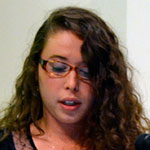 Cahrissa Dasso
Cahrissa Dasso
"Ultra Violence and Beauty: An Anti-Aristotelian Analysis of Stanley Kubrick’s A Clockwork Orange"
Stanley Kubrick’s classic dramatic thriller, A Clockwork Orange (USA, 1971), details the disturbing life of teenage protagonist, Alex Delarge, as he engages in a spree of horrific crimes, which lead to his attempted rehabilitation using a newly invented (albeit controversial) form of psychological conditioning. This movie is famous for its presumably excessive use of violence; however, this thesis argues that the violence is not simply excessive. An examination of the racy artwork and balletic fight scenes -- often accompanied by strains of Beethoven -- will reveal the movie’s argument with Aristotelian aesthetics. Whereas Aristotle’s theory of catharsis argues that art can purge violent emotions, Kubrick’s A Clockwork Orange insists the reverse. Kubrick’s depiction of Alex’s character reveals both that art is unavoidably connected to violence, and worse, that it often inspires it.
PANEL 5: EVOLVING HEROES
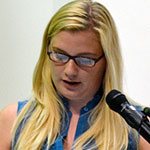 Mary Rafferty
Mary Rafferty
"Stars, Stripes, and Spandex: Captain America Retconning the American Heroic Ideal"
Captain America, the Sentinel of Liberty, has been fighting for the protection of American ideals since his Marvel Comics conception in 1941.The character has also been representative of a particular American ideology:The American heroic ideal. Over time, his character has been "retconned" (i.e., updated via retroactive continuity) to keep up with the constantly shifting ideals within a society that both produces and consumes his comic books, movies, and the other cultural productions bearing his name. By examining the original Captain America Comics of the 1940s in contrast to his 21st-century namesake in the film Captain America: the First Avenger (USA, 2011), this thesis reveals not only how his creators infuse the heroic ideal of Captain America into his story, but also how this character recursively contributes new qualities to an ideology that changes with each significant evolution of his character.
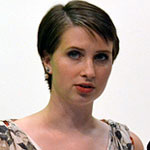 Alexandra Artiano
Alexandra Artiano
"Drive: Deconstructing the Hero"
The 2011 film Drive directed by Nicolas Winding Refn features a protagonist who is given no name in the script, but is credited as "Driver." The film sympathetically depicts Driver despite the fact that he commits brutal murders. This brings up the question of what kind of hero Driver is.This thesis analyzes the different parts of a modern hero, western hero and 20th century antihero that are evident in Driver’s character to define what kind of hero can exist in modern society, where justice and violence are typically seen as incompatible.
 David Chapleau
David Chapleau
"From the Shadows of Fangorn to the Fires of Mount Doom: Individuation in the Hobbits of The Lord of the Rings"
The most prominent flaw in Jungian criticism of J.R.R.Tolkien’s The Lord of the Rings (1955) is the gross neglect of Merry and Pippin in the discussion of the theory of individuation in the novel. This thesis examines the importance of including Merry and Pippin in the criticism, as they provide essential substantive evidence towards the presence of full, complete and comprehensive relevance of individuation in the development of the characters in The Lord of the Rings.
 Zachary Lyons
Zachary Lyons
"Rethinking the Hero: Marginalization in Shakespeare, Twain and Tolkien"
Marginalization of individuals and groups occurs in literary texts just as it does in real life. Shylock from William Shakespeare’s The Merchant of Venice (c. 1596), Jim from Mark Twain’s Adventures of Huckleberry Finn (1885), and Merry and Pippin from J.R.R.Tolkien’s The Lord of the Rings (1954) are all marginalized in various manners. By first investigating the ways in which the three texts marginalize characters and then comparing these characters to the ostensible heroes of their respective texts, this thesis illustrates the perhaps surprising claim that marginalized characters are sometimes more heroic than the heroes themselves.
PANEL 6: DECODING RACE, CLASS, GENDER
 Amanda Silva
Amanda Silva
"'Because It’s Where My Family Goes': An Ideological Analysis of Racism and Anti-Racism in The Blind Side"
Director John Lee Hancock’s 2009 hit film The Blind Side features the story of a young black man named Michael Oher. Michael has been a victim of poverty and has never had a steady home until one day, the wealthy and white Tuhoy family welcomes Michael into not only their home, but also their hearts. Some viewers claim that this film is racist, arguing that the whites are portrayed as saviors who hold racist assumptions. However, a close analysis of the film will reveal just how complex the issue of race truly is in The Blind Side. Furthermore, this ideological analysis will reveal three dominant ideologies and complexities -- classism, family values, and white privilege -- all of which the film uses to attempt to combat racism.
 Jared Wolf
Jared Wolf
"Breaking the First Rule of Fight Club: An Analysis of Gendered Social Reformation"
Chuck Palahniuk’s 1996 novel Fight Club features Bob, Chloe, and a narrator who, at various times in the novel, conform to both male and female traditional gender roles. This novel does not simply endorse the abandonment of these traditional gender roles. Instead, it endorses a balance of both masculine and feminine characteristics and behaviors across the sexes.This reading reveals Bob’s unsuccessful attempt to achieve that balance in contrast to Chloe’s swift and successful transformation. The narrator’s evolution towards that balance is slower and more complicated – it also involves the abandonment of consumerism as he develops in emotional maturity.
 Kristina Ragone
Kristina Ragone
"Invisible Hegemony: An Examination of Patriarchal Structures in Harry Potter, Tangled, and Shrek"
This thesis reveals the patriarchal structures present within today’s popular children’s literature. An examination of Harry Potter, Tangled, and Shrek shows that female characters in these movies actually demonstrate behaviors that perpetuate the patriarchal structures which they at first seem to avoid. This thesis will conclude that, after examining these popular children’s works, it is clear that these patriarchal structures are not only present in literature, but they are often invisible and pervasive.
American Literature of the 1960s: English Literature Senior Thesis Colloquium - May 12, 2011
Colloquium Poster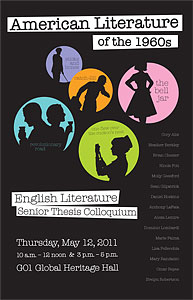
(click image for full-size poster)
Thesis Presenters
- Cory Alix
- Heather Berkeley
- Brian Chester
- Nicole Foti
- Molly Gessford
- Sean Gilpatrick
- Daniel Hoskins
- Anthony Lafata
- Alexa Lemire
- Dominic Lombardi
- Marie Palma
- Lisa Pellecchia
- Mary Randazzo
- Omar Reyes
Faculty Director

Jim Tackach, Ph.D.
For the duration of these senior essay projects, the 1960s were alive again.
The 60s were a time of great social, political, and cultural upheaval in the United States. They featured an unpopular war in Vietnam, the civil rights movement, a budding women’s movement, the arrival of rock-and-roll as the dominant popular music form, a youth movement, a revolt against suburban living, and other earthquakes on the American landscape.
The literature of the 1960s reflects this upheaval. In this course, we learned, through literary texts such as Joseph Heller’s Catch-22 and David Rabe’s Vietnam War play Sticks and Bones, that American authors had developed a different way of writing about way—a turn from gritty realism toward the absurd. Writers such as James Baldwin and Martin Luther King charted the movement for civil rights for African Americans. Sylvia Plath’s The Bell Jar, Betty Friedan’s The Feminine Mystique, and Richard Yates’s Revolutionary Road chronicled the dissatisfaction felt by many educated American women during the post-World War II years. In One Flew Over the Cuckoo’s Nest, Ken Kesey captured young Americans’ distaste for large institutions that were dominating American life. In the background was the music of Janis Joplin, Arlo Guthrie, Bob Dylan, the Motown bands, and the Girl Groups
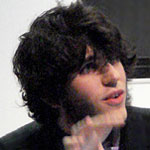 Cory Alix
Cory Alix
"'I am too pure for you or anyone': A New Approach Sylvia Plath, Esther Greenwood, and the Second Self"
One of the major problems currently facing Sylvia Plath criticism is the tendency of critics to conflate creator with creation. This mistake is perhaps the most prevalent in readings of Plath's novel, The Bell Jar (1963), where the life of the novel's narrator, Esther Greenwood, obviously parallels the life of the author. However, the simplistic conflation of Plath and Greenwood obfuscates a crucial artistic goal of Plath's corpus – the creation of an artistic "second self." This thesis explores The Bell Jar’s startlingly complex portrait of the artist (as a young woman) by focusing on Esther Greenwood’s attempt to create a second self.
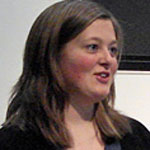 Heather Berkeley
Heather Berkeley
The "Two-Headed Schizophrenic": A Cultural Constraint Feminist Critique of Esther Greenwood and April Wheeler
This thesis examines the historical background of the roles and expectations of the "proper" American woman in the period before and during the 1950s by analyzing female characters in Sylvia Plath’s The Bell Jar (1963) and Richard Yates’ Revolutionary Road (1961). Esther Greenwood and April Wheeler struggle with the pressure to remain true to their identities, despite being suffocated by cultural expectations. Their quest for freedom exacts a cost that helps to define American cultural expectations of femininity during this era.
 Brian Chester
Brian Chester
Destructive Ideologies: Revolutionary Road and the Suburban Nightmare
Richard Yates’ Revolutionary Road (1961) focuses on the failing relationship of Frank and April Wheeler. The causes for the failure of their marriage are many and subtle. This analysis identifies one surprising negative influence: the suburban environment and its empty culture. Yates’ novel reveals that the destruction of their relationship is closely connected to the lure of the suburbs and the American Dream. It is this attraction that causes those who attempt to achieve the dream to fall victim to a never-ending chase that leads only to disappointment.
 Nicole Foti
Nicole Foti
"Out of the Kitchen and Into Actuality: Postmodern Literary Women as Free Agents"
Sylvia Plath’s semi-autobiographical text, The Bell Jar (1963), and Ken Kesey’s asylum novel, One Flew Over the Cuckoo’s Nest (1962) demonstrate different aspects of the changing status of 1960s literary women. This thesis illustrates a slow but significant progression toward a postmodern, deconstructed, agency-retaining, pluralistic female subject. The female protagonists of these texts, Esther Greenwood (Bell Jar) and Nurse Ratched (Cuckoo’s Nest) demonstrate how women of 1960s literature reject the essential truths of oppressive patriarchal binaries in order to assert a more wholistic, complex female identity.
 Molly Gessford
Molly Gessford
"Nurse Ratched as the Anti-Woman: Rebellion Against Patriarchy in Ken Kesey’s One Flew Over the Cuckoo’s Nest"
This thesis suggests that the head administrative nurse, Nurse Ratched, in Ken Kesey’s Cuckoo’s Nest (1962) can be read as a positive feminist figure. Nurse Ratched wields almost absolute control in the mental ward of the hospital. This thesis explores the idea that such control can productively be read as an attack against patriarchy, rather than an attack on women.
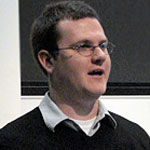 Sean Gilpatrick
Sean Gilpatrick
A Paper Reality: Bureaucracy and Subjective Reality in Catch-22
Joseph Heller’s novel Catch-22 (1961) depicts a world entrenched in bureaucracy, paperwork, and official documents. During the course of the novel, it becomes more and more apparent that, in the world of Catch-22, what is written down on paper carries more weight than what actually transpires. For Yossarian and his comrades, reality is dictated and decided by paperwork, and therefore it can be changed or altered at a moment’s notice. However, while the world of Catch-22 may appear to be absurd, it eerily mirrors social processes that are all too common: mistaking the written record for unequivocal fact, and replacing objective reality with a malleable paper reality.
 Daniel Hoskins
Daniel Hoskins
"Deserting Pianosa: A Darwinist Reading of Joseph Heller's Catch-22"
Joseph Heller's novel, Catch-22 (1961) provides a unique perspective on war. Instead of celebrating the heroism of the soldier and glorifying the combatants, Heller’s novel paints an absurd portrait of war with selfish commanding officers, administrative confusion, and a protagonist who is only concerned with his own survival. Reading the novel through a Literary Darwinist perspective explains this portrait of war as an adaptive function created over the process of intense competition during human evolution. Surrounded by war, Yossarian - the novel's protagonist- is constantly trying to avoid combat. In the process, he is trying to escape a war and, paradoxically, the Catch-22 of his own evolution.
 Anthony Lafata
Anthony Lafata
"Revolutionary Road: The Road to Revolutionizing the Female Role in Society"
In Richard Yates' Revolutionary Road (1961) April Wheeler reacts against the stereotype of the 1950s American Housewife. Her struggle through the novel is not merely to break free from marriage, but to break free from a lifestyle that required women to be subservient to men. April's desire to escape the housewife prefigures feminist writings of the time period such as Betty Friedan's The Feminine Mystique (1963). This thesis examines the way in which April Wheeler completely rejects the standard female stereotypes, while revealing her desire to escape, even if it means dying in the process.
 Alexa Lemire
Alexa Lemire
"The Homecoming of Vietnam Veterans in Sticks and Bones by David Rabe: The Effects of Post-Traumatic Stress Disorder on Family Life"
David Rabe’s absurdist play Sticks and Bones (1971) reflects the values of society in the 1960s during the Vietnam War. Rabe’s play tells the story of David, a Vietnam veteran blinded in the war, who returns home. He is, however, unable to peacefully re-assimilate with his own family. Displaying symptoms of post-traumatic stress disorder, David represents the reality of the veteran of that time as the outsider or "the other" whose own sense of reality is in direct conflict with the "Leave it to Beaver" reality endorsed by his own family. During this clash of realities, David’s outbursts become more violent and hurtful, which leads his family to react in a negative manner. Using David as representative of many Vietnam veterans, Sticks and Bones portrays the trauma of Vietnam veterans returning home in the 60s and 70s.
 Dominic Lombardi
Dominic Lombardi
"Confucian Relationships in the 20th Century: Revolutionary Road and the Five Basic Human Relationships"
Richard Yates' Revolutionary Road (1961) illustrates the degradation inherent in the suburban myth of the 1950s American dream. Yates traces a direct connection between this ideology and the destruction of the individual, the family, and the larger community. Drawing on scholarship tracing back to approximately 439 B.C.E. (the publication of Confucius' The Analects of Confucius) this thesis contrasts the American Dream with Confucian instructions about how to live a balanced life by balancing the Five Basic Human Relationships. These relationships - relationship between ruler and subject, husband and wife, parents and children, between siblings and between neighbors - dictate daily interactions within social realms and guide individuals towards harmonious living. In Yates' Revolutionary Road all of these relationships lack balance and thus lead to the utter destruction of every member of this novel’s community.
 Marie Palma
Marie Palma
"Living in a Petrified Forest: Exploring the World of Wheelers through an Ecocritical-Thoreauvian Lens"
This thesis examines Richard Yates’ novel, Revolutionary Road (1961) through an ecocritical lens, specifically, the lens of American nature writer, Henry David Thoreau (Thoreauvianism). Throughout the novel, Yates’ characters, Frank and April Wheeler, demonstrate an ambivalent relationship with the natural world, which places them out of sync with nature. This disjointed relationship is especially apparent in their chosen landscape – suburbia. The schism Yates reveals between these two realms (true vs. constructed nature) parallels the schism between Frank and April themselves. Although at times Frank and April as well as the community members featured in Revolutionary Road find refuge in nature, they nonetheless continue to isolate themselves from their environment and from their own true natures. Likewise, although they attempt to form a meaningful bond between themselves, they are out of sync with each other, and ultimately propel themselves into overriding conflict.
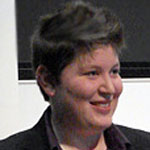 Lisa Pellecchia
Lisa Pellecchia
"Reinforcing Indoctrinability: The Rejection of the Fortuitous Feminist Mutation in The Bell Jar"
In Sylvia Plath’s The Bell Jar (1963), protagonist Esther Greenwood represents the emergence of the feminist movement even as she simultaneously acts in accordance with current sociobiological theory. However, her sociobiological identity exists in tension with the patriarchal ideology of the 1960s. Although Esther demonstrates the biological advantages of gender equality, her patriarchal culture rejects such progressive notions and enforces compulsory conformity. Esther’s species, in this sense, mistakenly observes her possession of the fortuitous feminist mutation as a debilitating force. It is, perhaps, this relentless tension that leads Esther to renounce her own existence. Esther’s numerous suicide attempts and tendencies can be understood as a consequence of species repudiation.
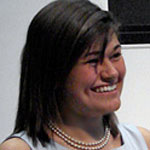 Mary Randazzo
Mary Randazzo
"Esther Greenwood’s Journey through the ender Landscape of the 1950s"
Slyvia Plath's novel The Bell Jar (1963) examines the life of Esther Greenwood and the journey she takes through the 1950's gender landscape. Esther is unlike many women of her time, who were often content with their station in life as mothers and homemakers. Throughout the novel Esther seeks to find a strong and independent female role model with whom she could identify, but she is often disappointed with the women she encounters. Esther also struggles with male patriarchy, a dominant force in 1950's American society. The Bell Jar is often seen as a novel wrought with mental hardship and struggle with seemingly no hope for Esther; however it is arguable that Esther does survive her battle with depression and is able to continue on with a strong sense of self and purpose, as she states so clearly in the novel, "I am, I am, I am."
 Omar Reyes
Omar Reyes
"The Nightmare of Suburbia: Frank Wheeler’s Emasculation in Revolutionary Road"
Although a great deal of scholarship on Richard Yates’ novel, Revolutionary Road (1961) focuses on patriarchal oppression of women, this thesis explores the process and causes of Frank Wheeler’s painful emasculation. His marital relationship is part of the problem. His wife April relentlessly questions and undermines his masculinity. This same dynamic is echoed again in Frank’s relationship to society and to suburbia itself – which both privilege mass anonymity over individual identity.
Writing the American Landscape: English Literature Senior Thesis Colloquium - December 2009
Colloquium Poster

(click image for full-size poster)
Theses Presenters
- Meaghan Attella
- Kathleen Coleman
- Elizabeth Gaudet
- Amanda Haskins
- Colleen Bergin
- Jaclyn Roche
- Jamie Silva
- Alyssa Schankman
- Kurt Schlagenhauf
- Sarah Stewart
Faculty Director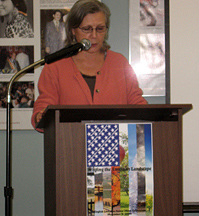
Dianne Comiskey, Ph.D.
Take a journey with us through time and place...
Travel to a remote orphanage and an apple orchard in Maine and examine the landscape of John Irving’s The Cider House Rules. Take the roads across New England to a small Adirondack town in upstate New York where Russell Banks explores the nature of accidents on a winding snowy road in The Sweet Hereafter.
Imagine yourself in 1930’s rural Alabama and understand that the prejudice you witness in Harper Lee’s To Kill a Mockingbird may be the result of an intolerance that is part of the very fabric of the place.
Head west to John Steinbeck’s California, and spend some time with the residents of Cannery Row. See how they deal with moral issues and class.
Wander back in time to 1491 when indigenous people inhabited this continent before they encountered a white face. Then listen to how both the writings of early European colonists and contemporary American Indians sought and seek to identify with a land that must be shared.
And if you can bear it, travel a bit farther to a post-apocalytic land where the pilgrims have no names, and the earth is indistinguishable from the ash falling from the sky in Cormac McCarthy’s The Road.
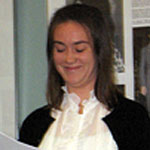 Amanda Haskins
Amanda Haskins
Cormac McCarthy thrusts his audience into a post-apocalyptic world in The Road. Beyond the frighteningly pragmatic and nihilistic style, McCarthy heavily relies on naturalism to demonstrate the connection between human beings and their environment. The extreme nature of this environment, the world after a decimating catastrophe, forces characters to be fully exposed and gives the reader a glimpse into their minds to see how drastically they are affected by the radical changes in their surroundings. Once in this situation, characters must consider all parts of survival, including fulfilling physical needs but also reevaluating morals, values, and ethics. By exploring the different ways in which human truths are revealed in The Road, it becomes apparent that the landscape is by far the most influential factor in shaping the characters in the novel.
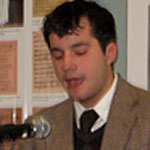 Kurt Schlagenhauf
Kurt Schlagenhauf
Romanticizing Flawed Morality in Harper Lee’s To Kill a Mockingbird
Since the release of the novel in 1960, critics and readers have proclaimed Harper Lee’s To Kill a Mockingbird to be an anti-racism masterpiece. The character Atticus Finch has been placed highest on this pedestal, many citing his heroism and morality. However, upon a closer analysis of the text, it is revealed that Finch is not the hero that readers have purported him to be. In fact, he is little more than a morally flawed man impacted by a lifetime of growing up in the racist, and sexist, south of the United States.
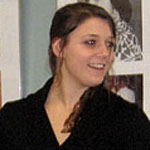 Jamie Silva
Jamie Silva
Tracing Footsteps: Landscape’s Construction of Characterization in John Irving’s The Cider House Rules
This essay reveals the major role landscape plays in John Irving's novel. By developing the landscape as thoroughly as his characters, Irving ultimately creates a parallel between the two, and ultimately establishes landscape as an influential force within the novel on part with the role of the characters themselves. Focusing primarily upon the novel’s two landscapes, “here in St. Cloud’s” and “out there in the world” this thesis examines the noticeable effect landscape has on the construction of the characters and these characters' dispositions.
 Elizabeth Gaudet
Elizabeth Gaudet
Determinism and Eco-criticsm in Russell Banks' The Sweet Hereafter
This thesis examines Russell Banks’ The Sweet Hereafter using determinism and eco-criticism. Banks’ story is about a school bus crash in Sam Dent, NY that results in the death of fourteen children. These deaths transform the residents of Sam Dent, especially Banks’ four narrators, Dolores Driscoll, Mitchell Stevens, Nichole Burnell, and Billy Ansel. Each of these four different narrators deals with the deaths of the children and living with the memory of the awful crash. These four narrators each have a unique perspective about the bus crash, but each also seems to be wondering the same thing: why does the crash happen? One of the novel's deterministic answers to this question is, as lawyer Mitchell Stevens believes, “there are no accidents.” This determinism is even more apparent in Banks' use of landscape, which, like fate may or may not have the ability to control a character.
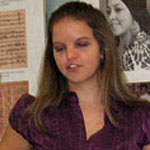 Alyssa Schankman
Alyssa Schankman
Scalpers, Cannibals, and Babies Hung From Bushes: Justifying Violence in Cormac McCarthy's Landscapes
This thesis investigates the role of landscape in Cormac McCarthy’s Blood Meridian (1985) and The Road (2006). Using elements of ecocriticism and psychoanalytic theory, my thesis reveals what the landscape's ability to evoke or emphasize the social, environmental, psychological, and biological reasons why people act aggressively by force, instinct, or choice. This thesis also discusses how the American landscape both causes and is victimized by violent human behavior.
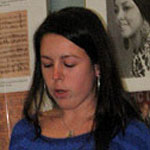 Sarah Stewart
Sarah Stewart
Carrying the Fire: The Rebuilding of Morality and Identity in Cormac McCarthy's The Road
In his novel, The Road, Cormac McCarthy provides his readers with ambiguous clues about the characters and the landscape. The world of The Road has been devastated by a disaster; the landscape is dark, covered in ash, entirely silent, and devoid of life. In order to survive in the new world, both father and son have to struggle to rebuild their individual identities as well as redevelop a sense of what is right and what is wrong. The landscape both reflects and creates this words: McCarthy minimizes details of the characters and their surroundings, reflecting the father and son's struggle to adapt to a bereft world.
 Meaghan Attella
Meaghan Attella
The Everlasting Effect of White Colonialism on Native American and Austrailan Indigenous Peoples
For centuries the lives of Native Americans have been affected by the lingering influences left by the white colonists. However, through Native American literature, the true voices of indigenous people can be heard, and through their words the past aligns with the present, and history finds itself in the modern day. My hope when I first began my research was to hear these voices, and to examine how Native Americans speak to the country through their literature, despite the fact that they have remained unnoticed. I examined Louis Owens' Bone Game, Louise Erdrich's Jacklight and James Welch's Winter in the Blood. In contrast to examine the early white American portrayal of native people, I also studied works such as William Bradford's History of Plymouth Plantation, Mary Rowlandson's narrative of her experience with Native American Indians, and Jon Smith's The Generall Historie of Virginia, New England & the Summer Isles.
 Jackie Roche
Jackie Roche
Home Grown: The Nurturing Landscapes of St. Cloud’s Orphanage and Worthington’s Apple Orchard in John Irving’s The Cider House Rules
In The Cider House Rules John Irving creates two landscapes -- St. Cloud’s orphanage and Worthington’s apple orchard. These landscapes both reflect and influence the two very different characters that develop upon them, Homer Wells and Wilbur Larch. Larch is lost living at the orphanage without Homer, while Homer is lost living there as a child. Homer must move to a place where he can be free, and he finds that place in Worthington’s apple orchard. Once Homer is free from the dreary St. Cloud’s, he finally figures out who he actually is, while Larch locks himself up in an isolated environment, and feeds his ether addiction. It is evident that humans respond to our environments; Irving’s Cider House rules both reveals and explores this connection between the landscape within the individual and the landscape without.
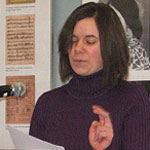 Kathleen Coleman
Kathleen Coleman
Good Books: The Search for a Moral Center in John Steinbeck's Fiction
The moral messages conveyed by John Steinbeck's texts bridge the gap between text and life by eliciting fundamental questions about morality. However, as a result of the narrow scope through which many readers often examine it, morality is a difficult topic to explore. My search for a moral center across the canon of Steinbeck's fiction (including Of Mice and Men, Cannery Row, Sweet Thursday, The Grapes of Wrath, and The Winter of Our Discontent) employs both an intrinsic and an extrinsic ethical examination in order to reveal important aspects of Steinbeck's technique, as well as to foreground the analysis of morality in fiction itself.
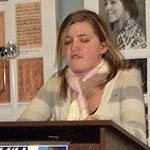 Coleen Bergin
Coleen Bergin
A Place Without Children Loses Its Meaning: Death’s Power over Human Beings in Russell Banks' The Sweet Hereafter and Cormac McCarthy's The Road
Both Russell Banks' and Cormac McCarthy's novels explore the effects of death on human beings. In each novel, death arrives differently: in The Sweet Hereafter, death arrives through a bus accident, killing several school children. In The Road death surrounds the few characters left in a post-apocalytic world. Perhaps because the nature of death is so different in both novels, the way the characters learn to live life is also different. In each novel, however, the immediate effect of catastrophic death is, paradoxically, to define life for the ones left behind.

